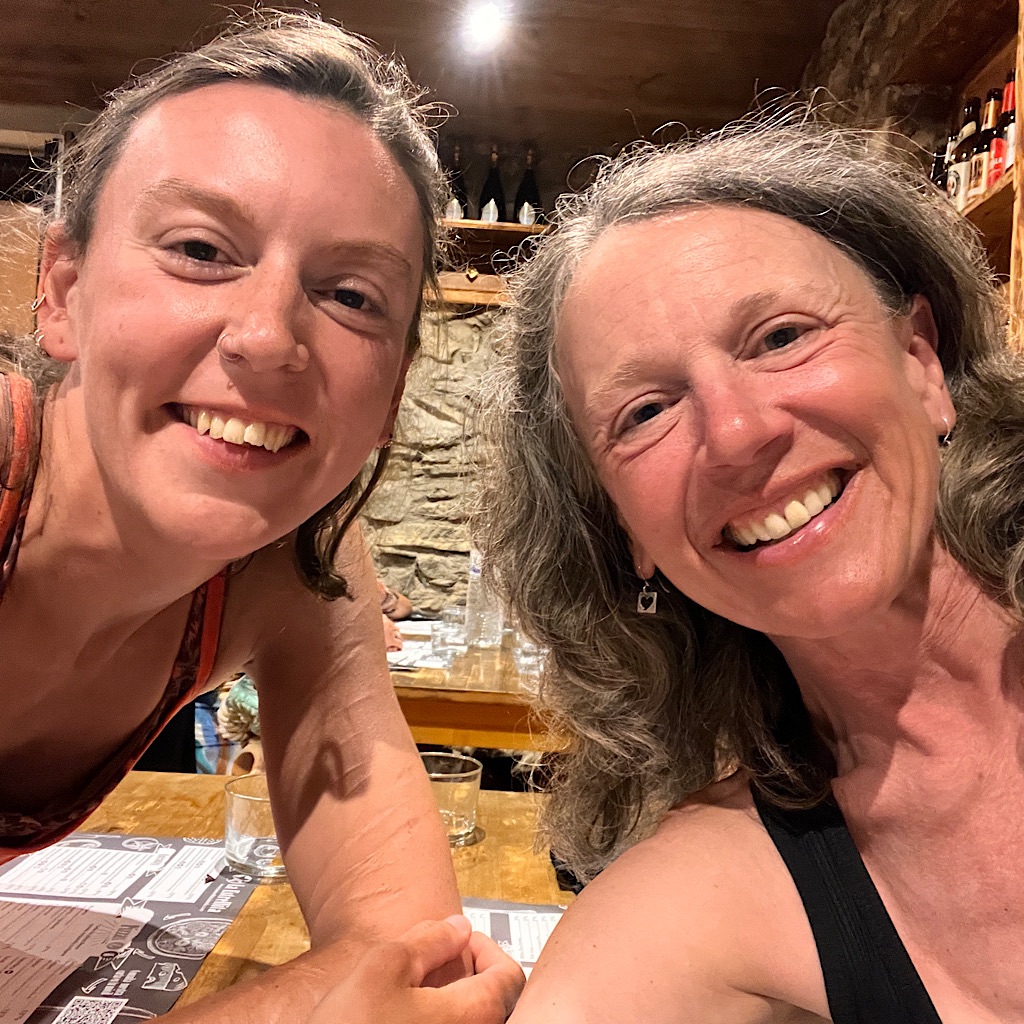
Central Pyrenees
Day Eighteen, Camping el Forcallo to Lac des Isclots
Last night there was a whole group of HRPers hanging around the campsite restaurant.
I sat mostly with the Polish couple and a German and Englishman both living in Belgium and making “loud dissonant” music together – plus hiking.
Marta was lamenting her final few days and looking forward to the wild, grade E (exceptional) terrain ahead.
She then told me the only thing that divides courage from stupidity, is the result.
Well good weather is ahead and we now have a small posse, which includes an Israeli hiker closer to my age named Tamir.
When I meet him, he tells me we already met at the bridge way back in the Basque Country.
But let’s face it, everyone looks different out of hiking clothes.
the bestest of days
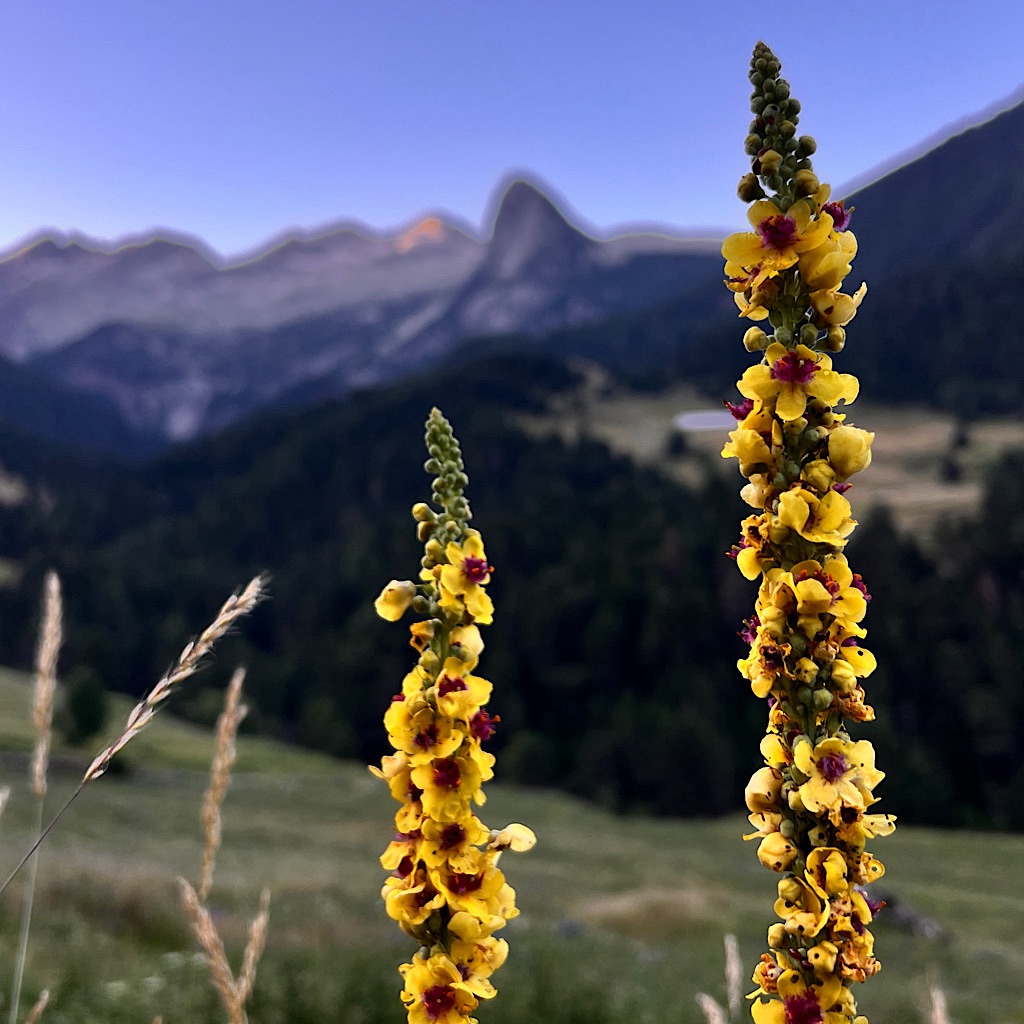
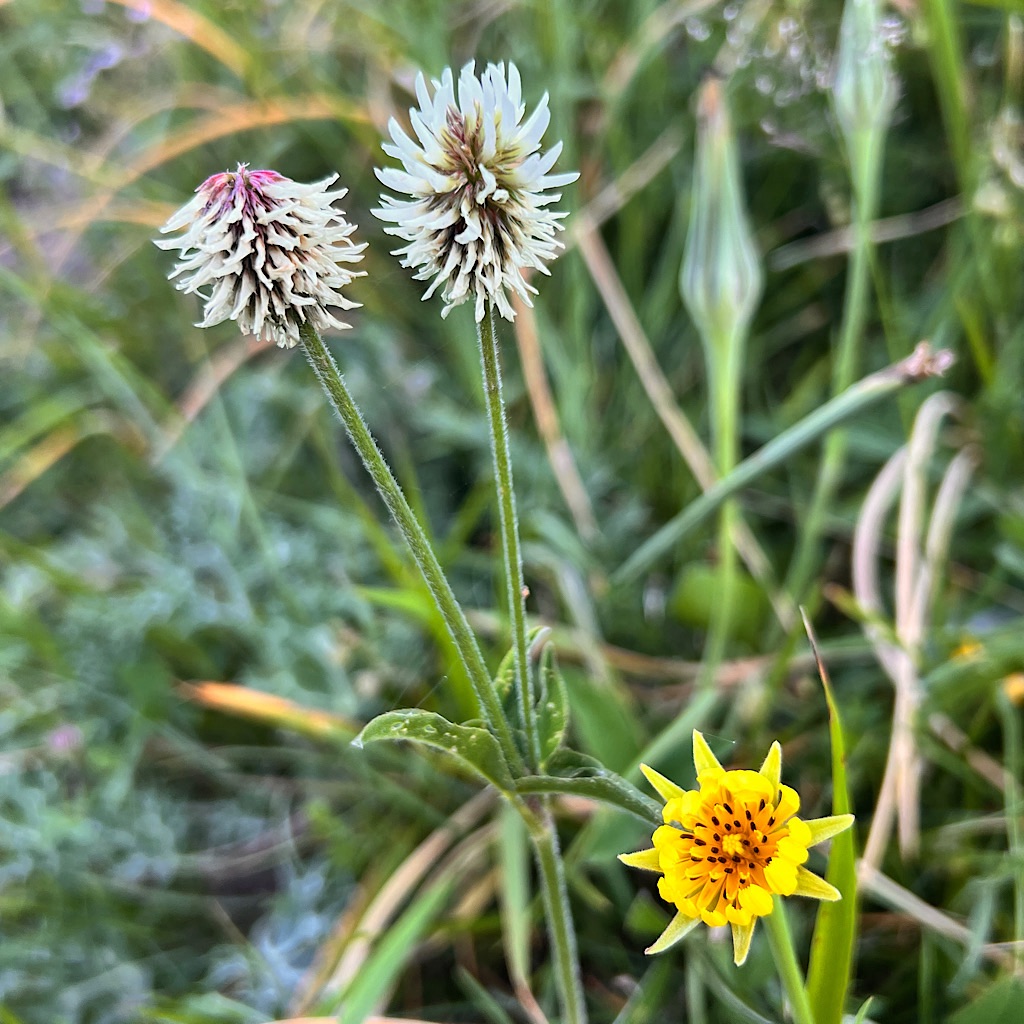
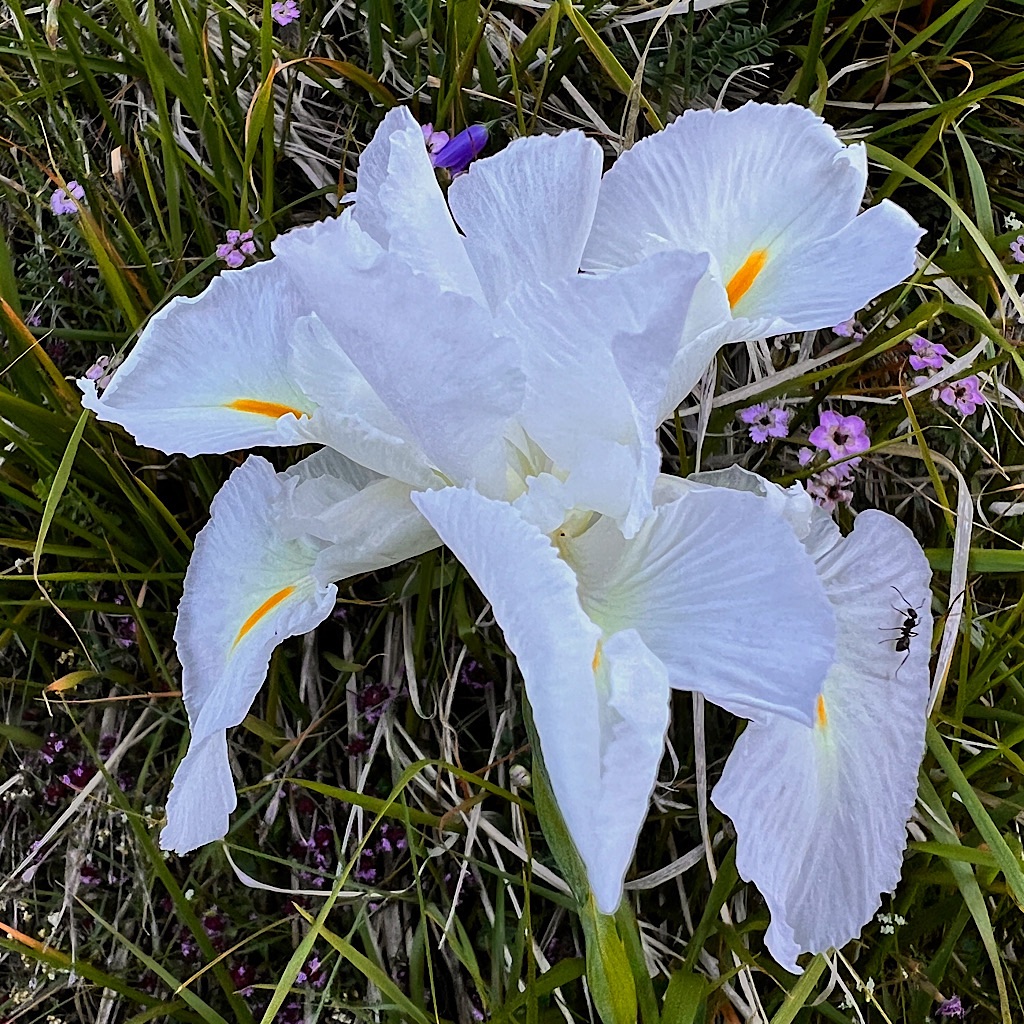

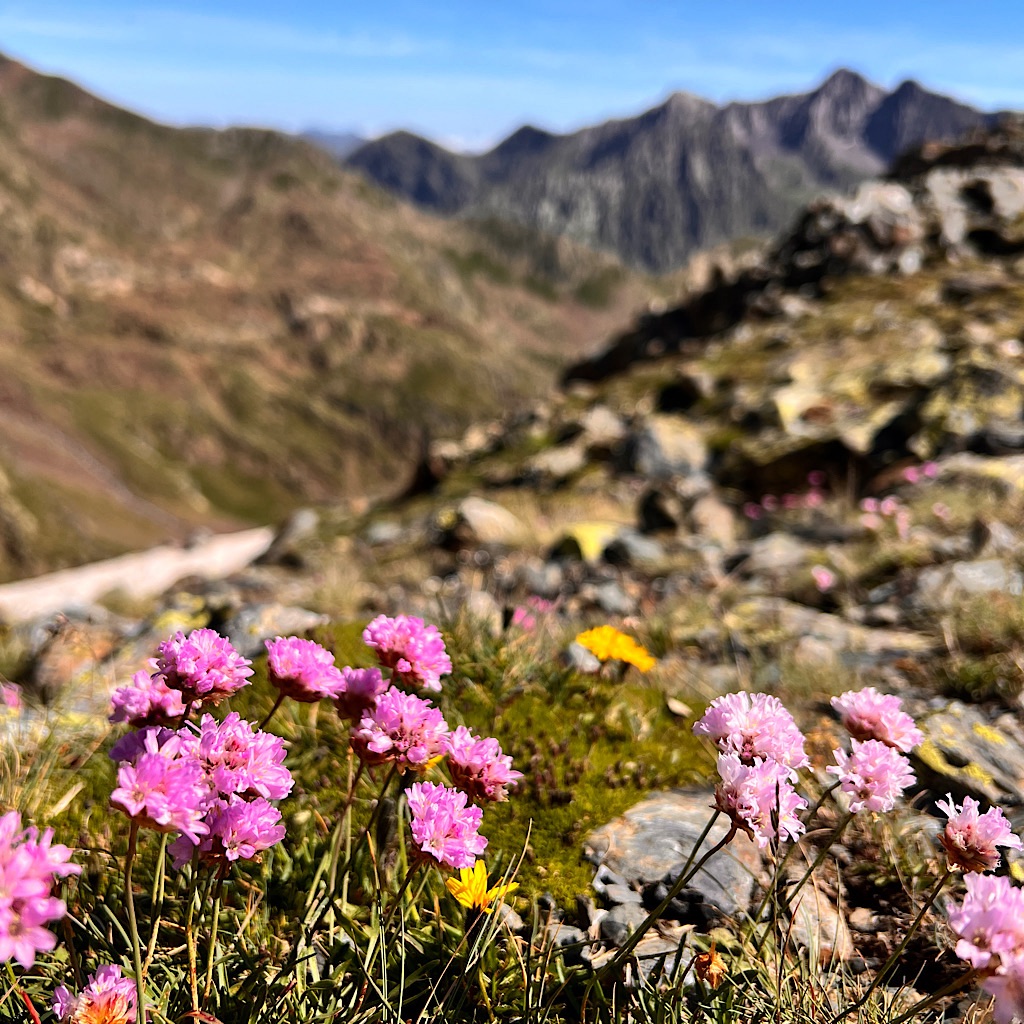
Floris, Evelina, Tamir and I will take on the upcoming hard stuff together. It’s not like I don’t have to walk – and watch – each step, but there’s definitely better decisions made when in a group.
After slogging on road for the GR11, I am so ready for some excitement and challenge. It starts soon enough, but first a coffee.
I screwed up and bought decaf instant in Parzán. I need the real thing and Refugio de Viodós is open for business.
I slurp it down with a few added sugars, then walk a bit more on the GR11 through the Valley of the Barranco de Añescruzes. A river is loud and boiling in a deep canyon to my right as I pass one beautiful stone barn after another.
The morning is cool, perfect really, the fields full of wildflowers, most notably the deep purple irises. Tamir catches up to me and we walk together is this Eden still out of the sun’s rays. What a surprise to come upon a white iris.
Soon we come to where three streams meet and now the fun begins. The German and Brit are here eating breakfast, but I decide to head up the steep, cairned “path” to Port d’Aygues Tortes. Path has to be in quotes now because I’ve returned to the HRP in a sense at this moment.
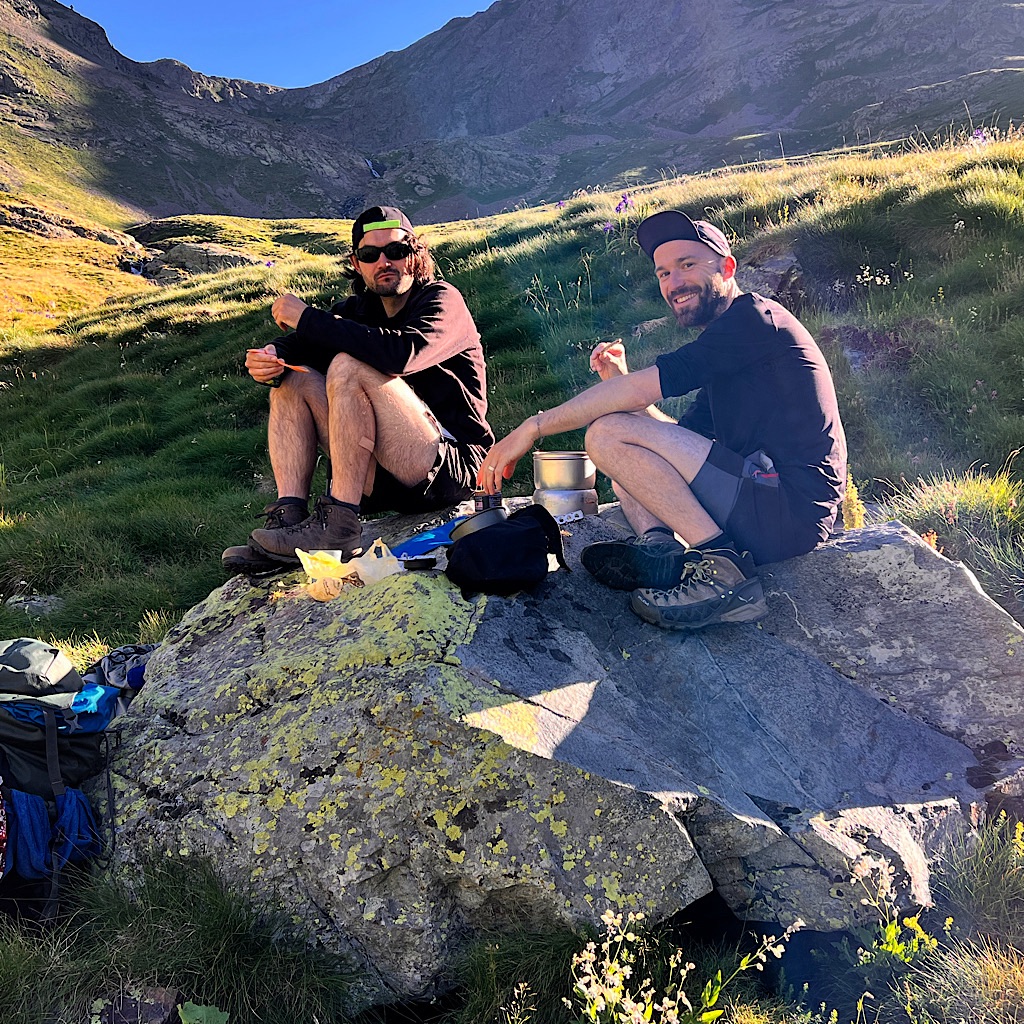
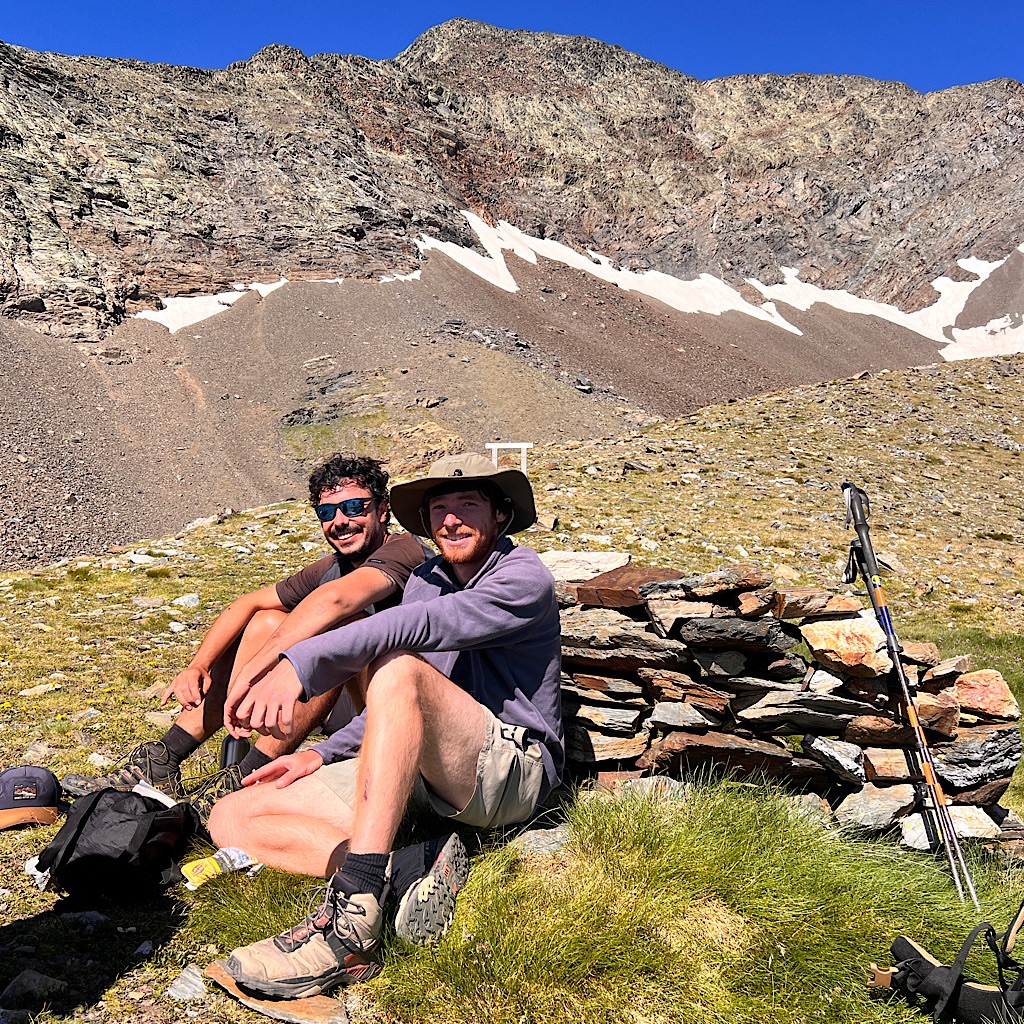
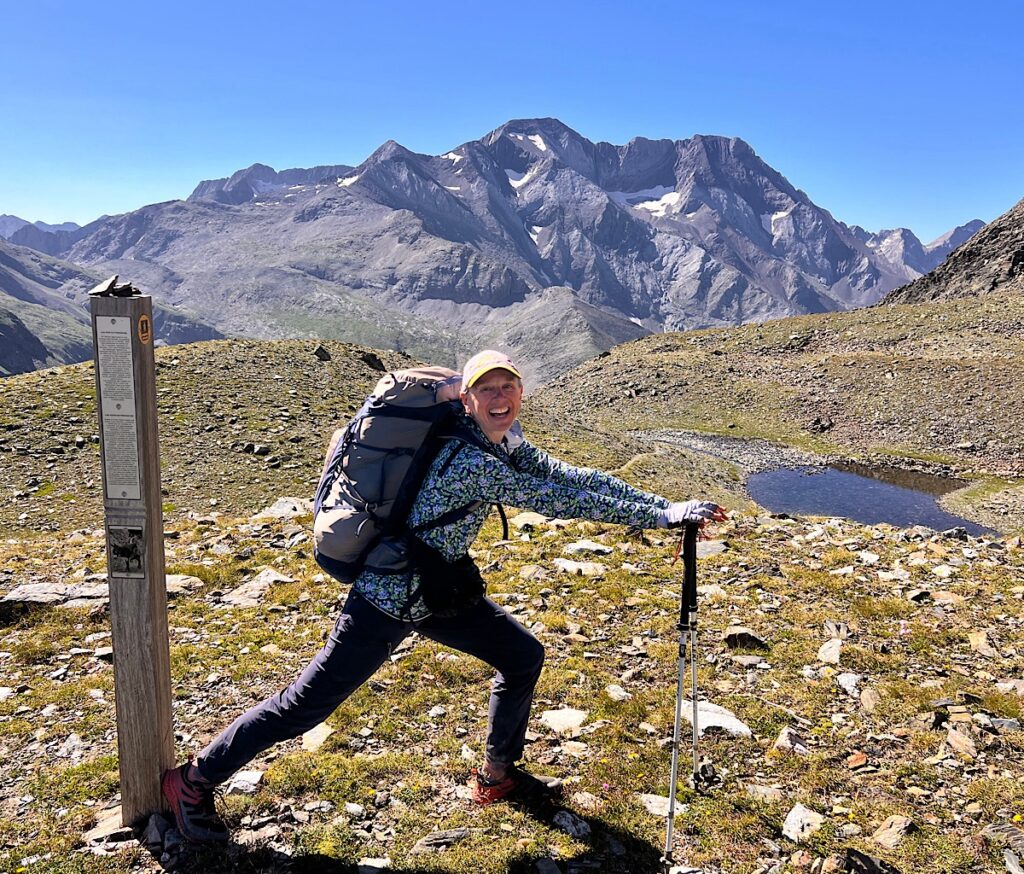
It’s pretty well straight up, on grassy steps at first, then into boulders. I lose the cairns and head too high, having to carefully watch each footfall through this maze.
A plateau gives me only a moment of reprieve when I need to join a slippery scree slope right alongside a crashing waterfall. It’s wide enough, just, but my body lunges forward as I rise as if I’m crawling.
Then it’s back to grass and rocks and hiking “below my breath” until I reach a gorgeous spot where two branches of the stream meet. I get water and look down into the chasm I just climbed.
Then up to the top finally, where a couple of French HRPers coming from the opposite way offer advice, including that the snow is not all that bad. Phew!
Butterfly
Soon Tamir arrives and the Dutch and it’s a little party at the pass. Tamir tells me he watched me climb and the way I move looks like I float, like a butterfly.
I’m so touched, though I know up is my secret power. It’s down that gets me, and here is where Tamir – a man in his 60’s – just throws himself down the mountain.
It’s a scree slope, though not overly slippery. I place my feet carefully so as not to slide and fall backwards, injuring a hand or knee. Fortunately, Evelina too takes it carefully so I don’t hold up the entire group picking my way down this mountain.
We enter a gorgeous valley fed by the melting snow – which ahead has been dammed – and the sky is so clear, the air so sweet and fresh. Ahead is an unmanned hut, Refuge de Prat-Cazeneuve, neat and clean.
We eat in the shade and a young Spanish hiker offers to fill my water bottle, then tells me it’s really heavy.
And your point?

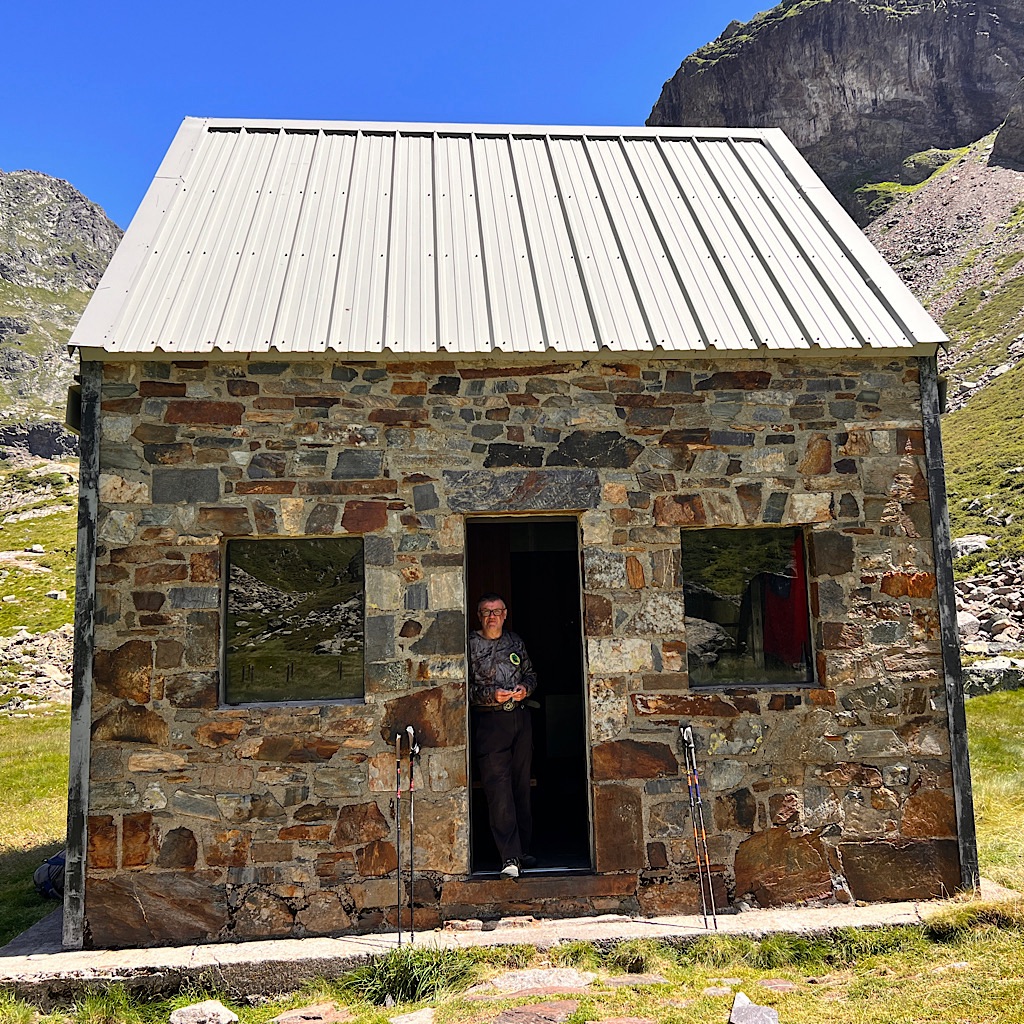

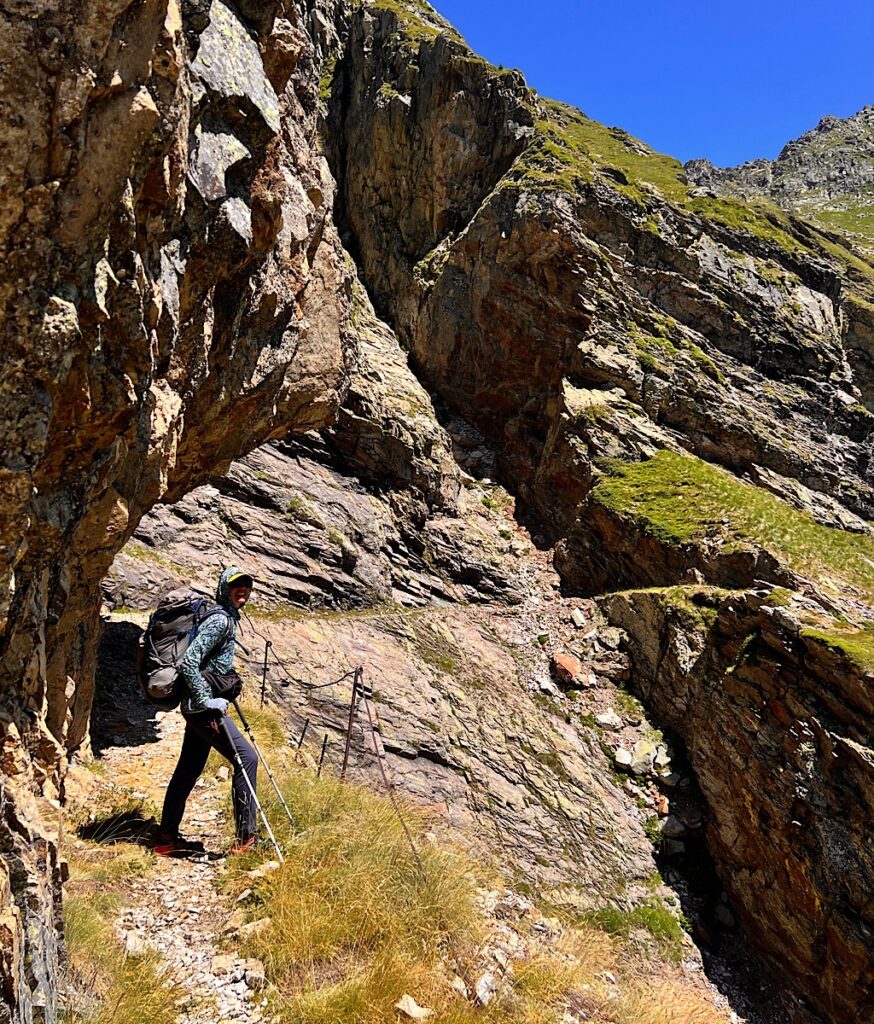
intro to hard stuff
From here, we’re able to take a shortcut to the high route and avoid going deep into the valley. It’s stunning as we rise high on a thin bit of trail as if floating on the air.
This whole area was mined and we walk on ancient trails, roads, even tracks. At one point we walk an area dug out of the cliffside. Rusted and bent metal protective gates remain, but it’s wide enough not to feel like you’ll fly off 1,000 feet to the valley below.
Around the mountain we go, gaining altitude and finally meeting the meat of the mines. It starts with some metal arches, then ruins, then an odd building which we simply walk straight through, then up stairs – you read that right, stairs!
But things get steep fast as we work our way up to Lac de Caillauas. It’s another dammed lake in a deep turquoise, far below. Someone has scrawled “Home Sweet Home” on ruins.
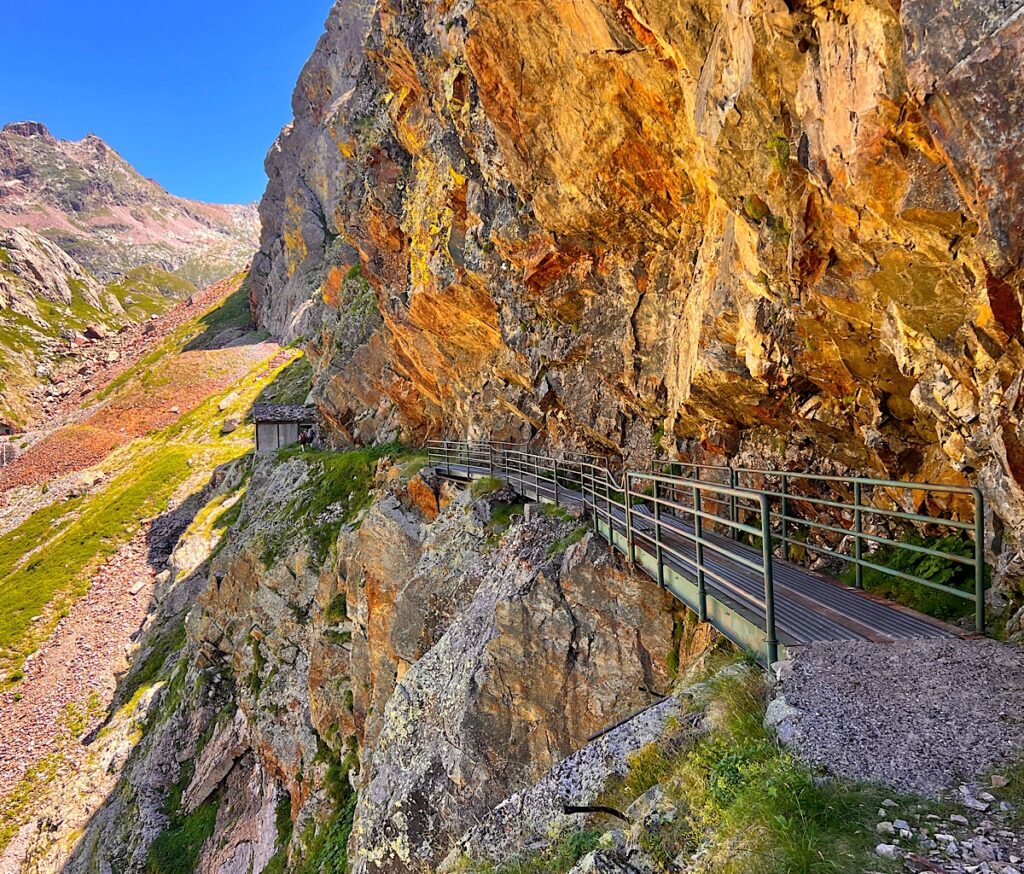


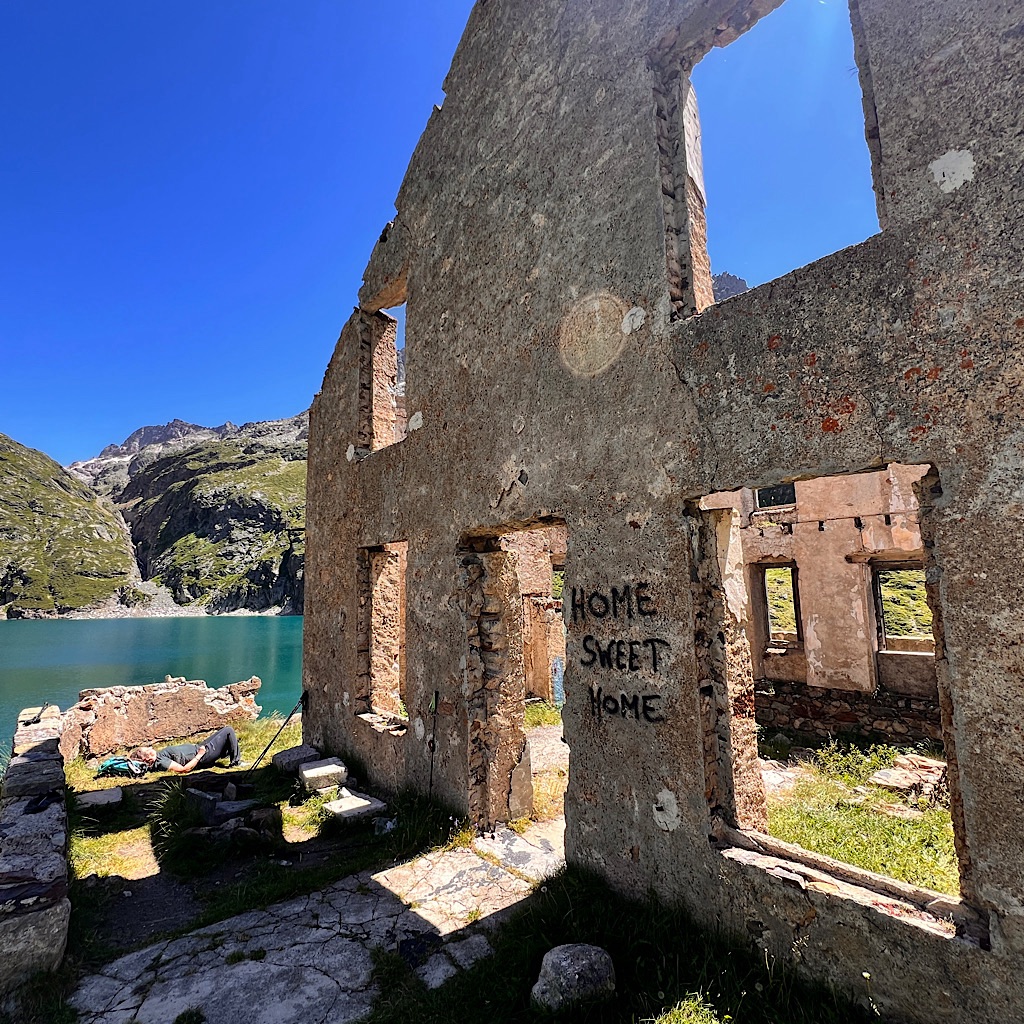
I cross the dam and Floris tells me we’ve entered the “E” section. Things heat up right away as we climb up boulders and I almost lose my trekking pole on one slick spot.
It’s steep moving up though billberry, then just rocks, heavy breathing all the way at the end of a long day, and finally we arrive at Lac de Isclots under a giant waterfall (no doubt draining the snowfield we’ll march up tomorrow.)
We set as more people arrive, a homey, friendly bunch mostly French. It’s beautiful here as the sun sets, giving an orange then pink glow to our small peninsula and islands.
I am so happy to have had this day. One that gave me a workout, but one so beautiful and filled with surprises and oddities and friendships, and ending at such a glorious place with not a single cloud in the sky.
Tomorrow will be even more wild and exciting, so now I’ll rest up with a waterfall as my lullaby.
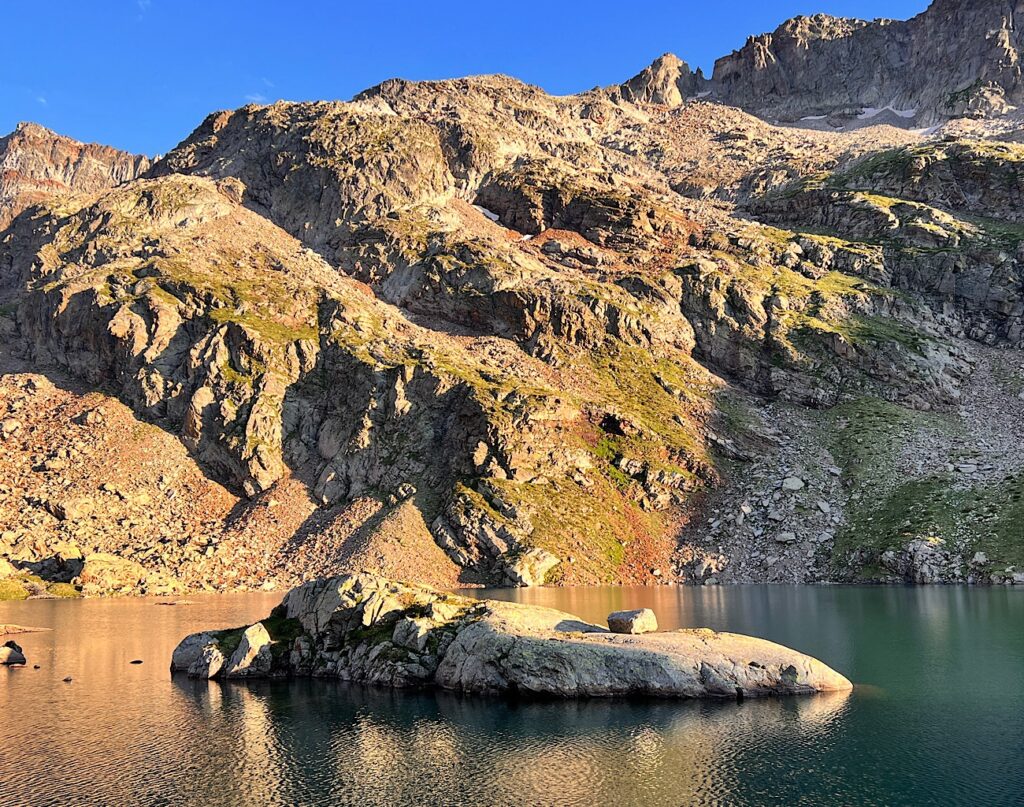
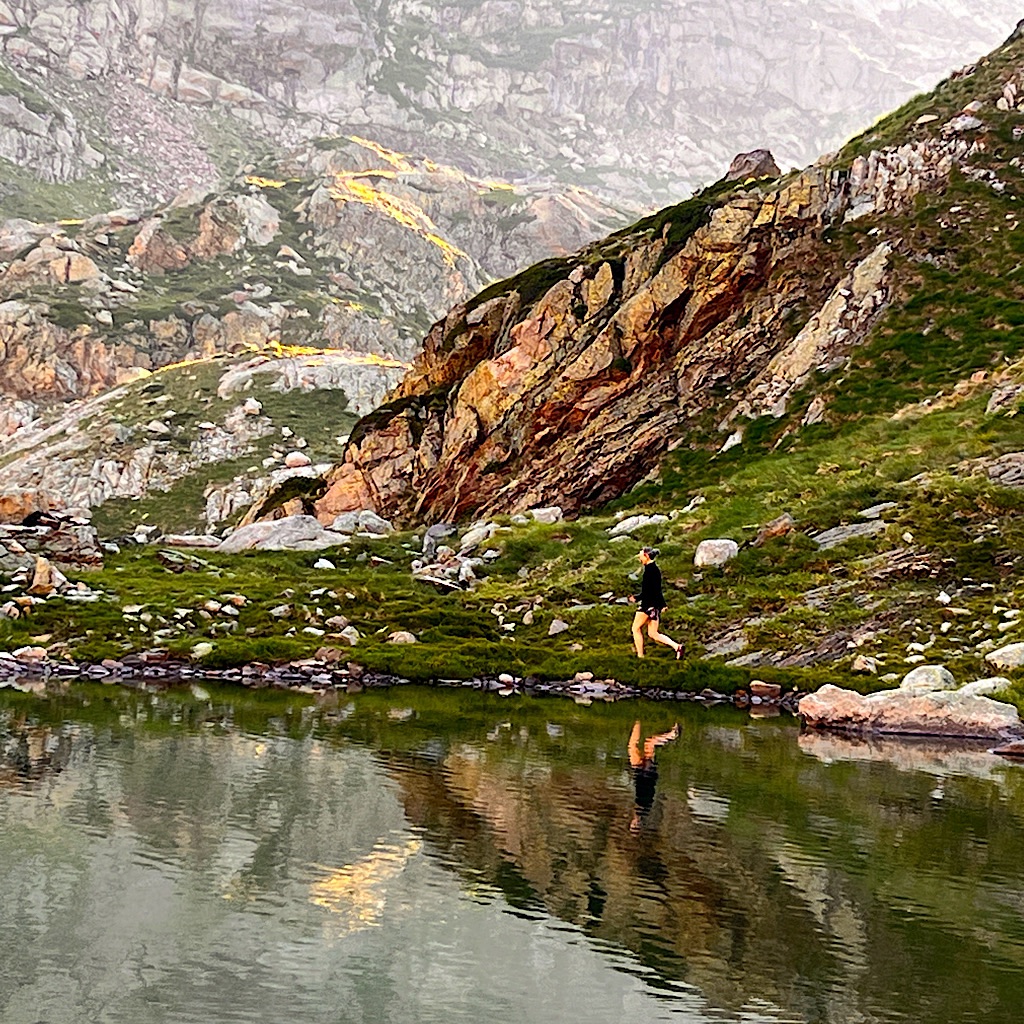


Day Nineteen, Lac des Isclots to Barranco de Remuñe
Taking notes from other hikers’ blogs I wrote one word (with punctuation, naturally) to describe today – ROCKS!
Even the guidebook gets in on the action, but with a more poetic description – “chaotic granite wilderness.”
This should leave absolutely no doubt in your mind why I am absolutely crashed in the alicoop now, cozied up in my big orange sleeping bag looking out at a spectacular view of those very same rocks, plus a private waterfall and a marshy meadow filled with exploded flowers like rows of Qtips.
It was snow that had me nervous for today. Long, steep crossings in sloppy, melting snow with rocks waiting below to catch my fall.
Truth is, it was the endless boulder fields, the unsecured tippy stones, the scree fields on a 70-degree slope, and the rock climbs that almost dod me in – and certainly earned this day its “E” for exceptionally technical.
But what a fantastic day shared with three friends, who in the end, balanced out each other’s skills.
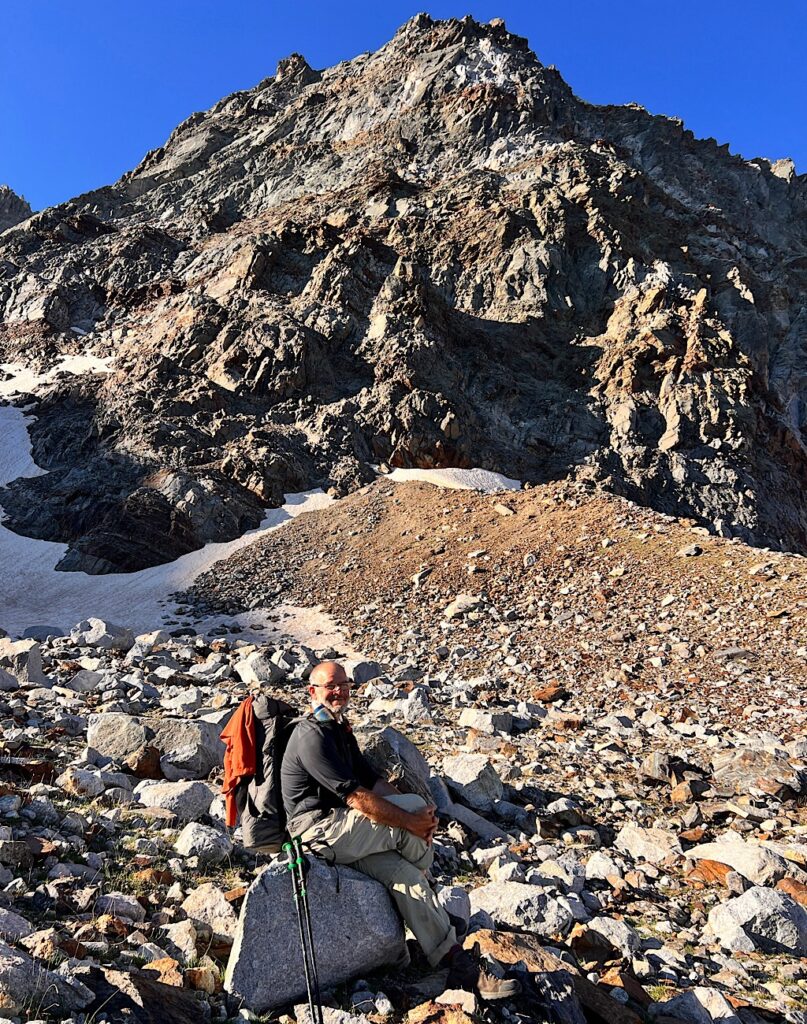
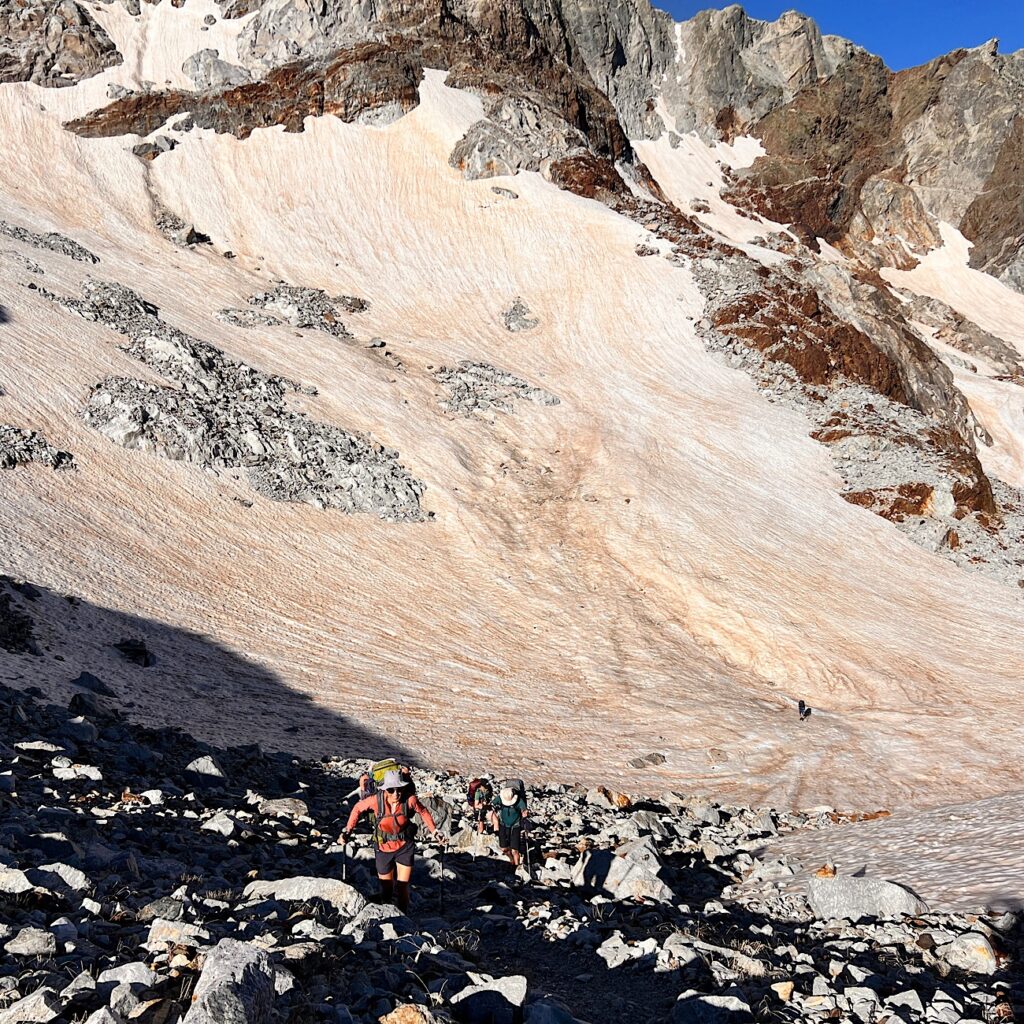
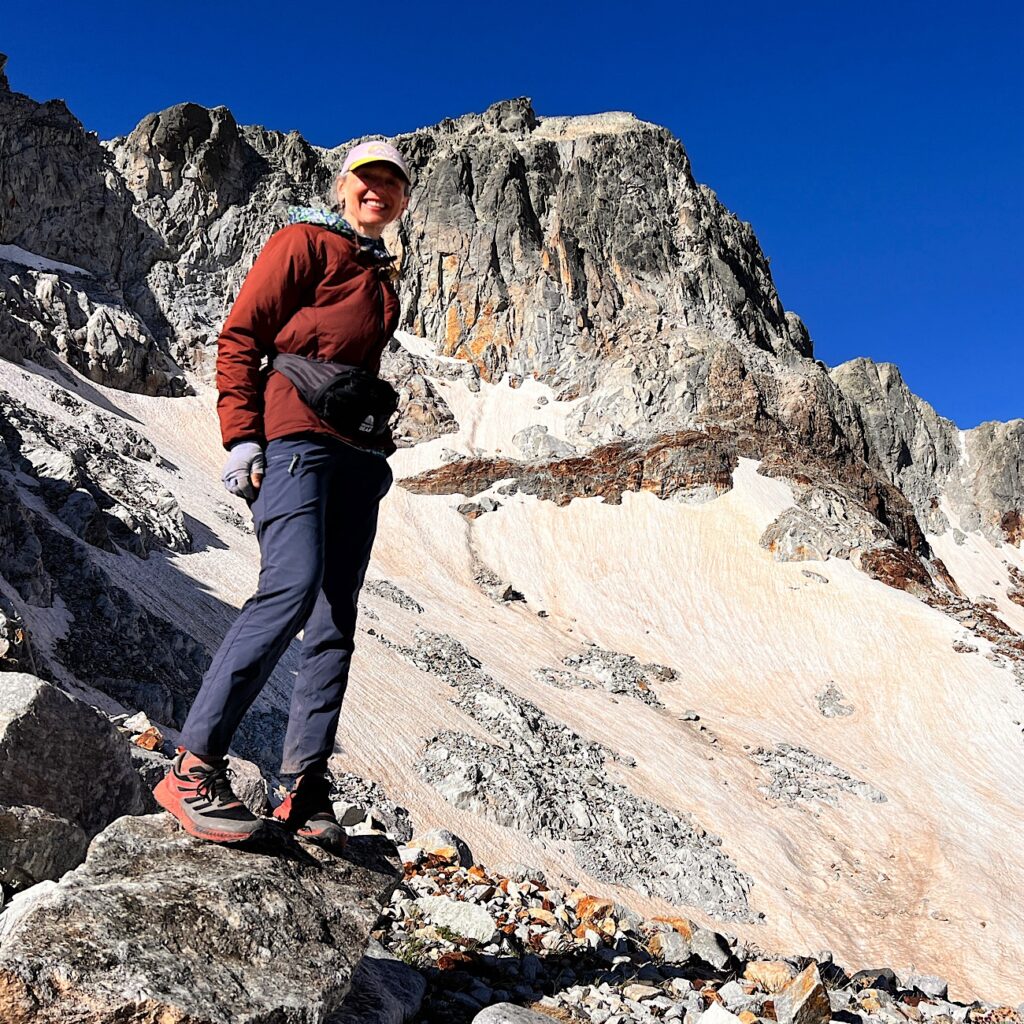

That’s three cols in a day, including the highest
We set ourselves up by bivouacking at Las des Isclots to get just under the first set of high cols, get to Refuge du Portillon, to eat and rest for a few hours, then take on the next col, the highest on the entire HRP, just a few meters shy of 3,000.
What we hadn’t anticipated was not finding suitable camp spots right away, and having to end a high-intensity day climbing over boulders for hours.
Dawn in this beautiful place is magical. I hear Tamir’s tinkly alarm and he is up and packed within minutes. The first part of the hike to Col des Gourgs-Blanc is a fairly well marked trail to another lake. We had thought of camping here, but I’m glad we didn’t as there’s only a thin bit of flat green taken over by sheep (I know! What are they doing here?!?)
Then, it’s boulders. I whine in boulders, curse and fuss, laugh a bit and say lots of encouraging words to get myself through.
It’s short and manageable and I see Tamir on the scree slope ahead. It’s short switchbacks marks by cairns climbing almost vertically to a plateau. He’s seated on a rock as if awaiting my arrival, likely because now it’s time to plod through the snow.
Let me tell you, snow is way easier to walk on than rocks. He doesn’t have crampons but does just fine on this slightly harder morning snow.


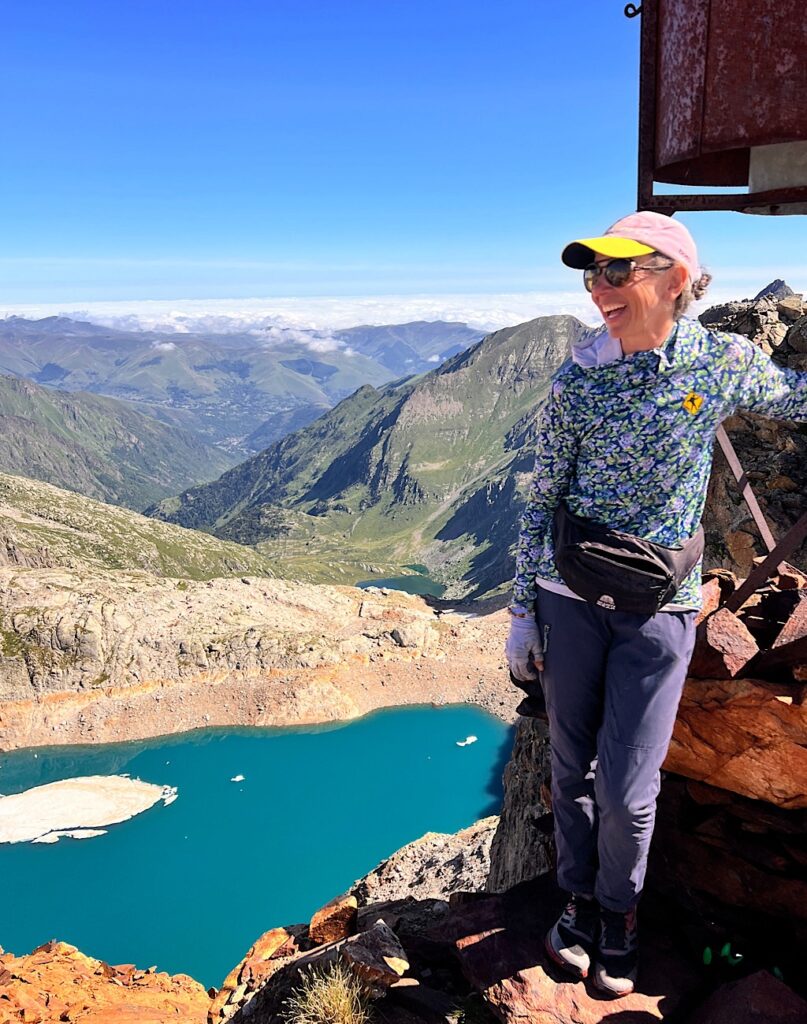
We march up, get a bit lost on which side to take, but eventually end up at another steep scree slope, thankfully not covered in snow, and pop to the top before the young ones reach us.
Tamir cooks breakfast and I admire the wild view of massive pointy peaks and snow seemingly everywhere.
Both the Dutch and French couple eventually arrive and now the question is how to get down. People are coming up the glacier, but they’re carrying ice axes and it’s far too steep for our motley crew (the French too didn’t bring crampons)
So it’s a wildly steep scree slope to rock, then snow, rock, snow. I march as high as I dare to the Col du Pluviométre (so named for the massive rain gauge just above the pass) and walk the last bit on steep rock.
Below is Lac Glacé de Port d’Oô (I really just wanted to write out that name; cute, huh?) and a glimpse at Portillon.
Geez, it’s just right there!
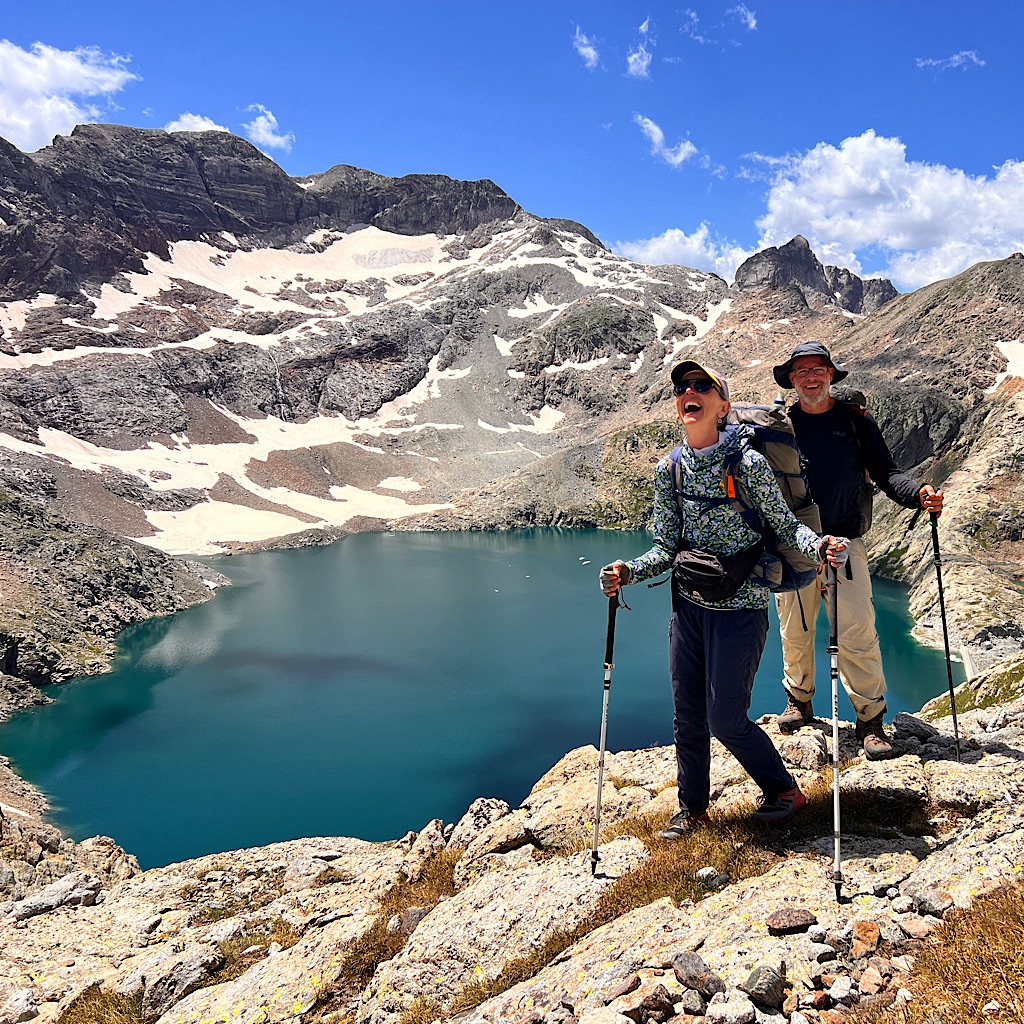
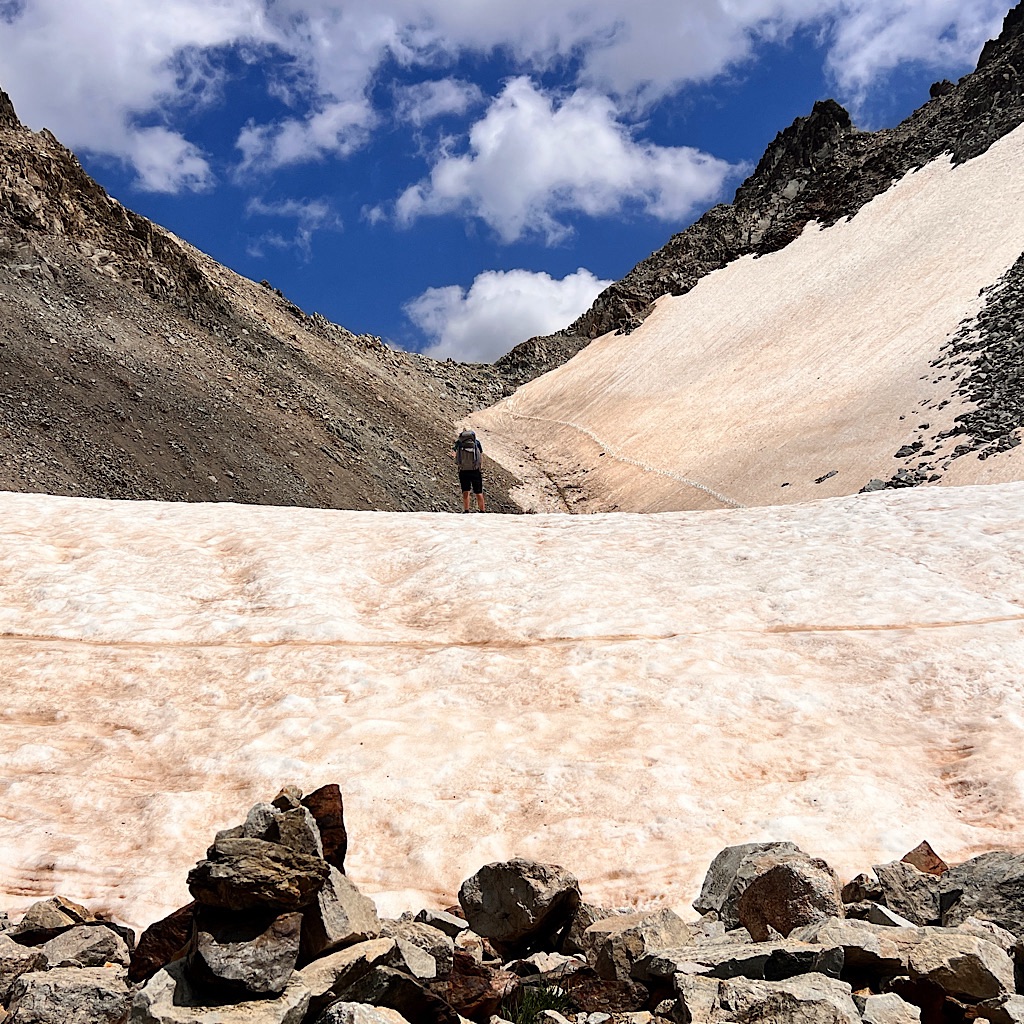
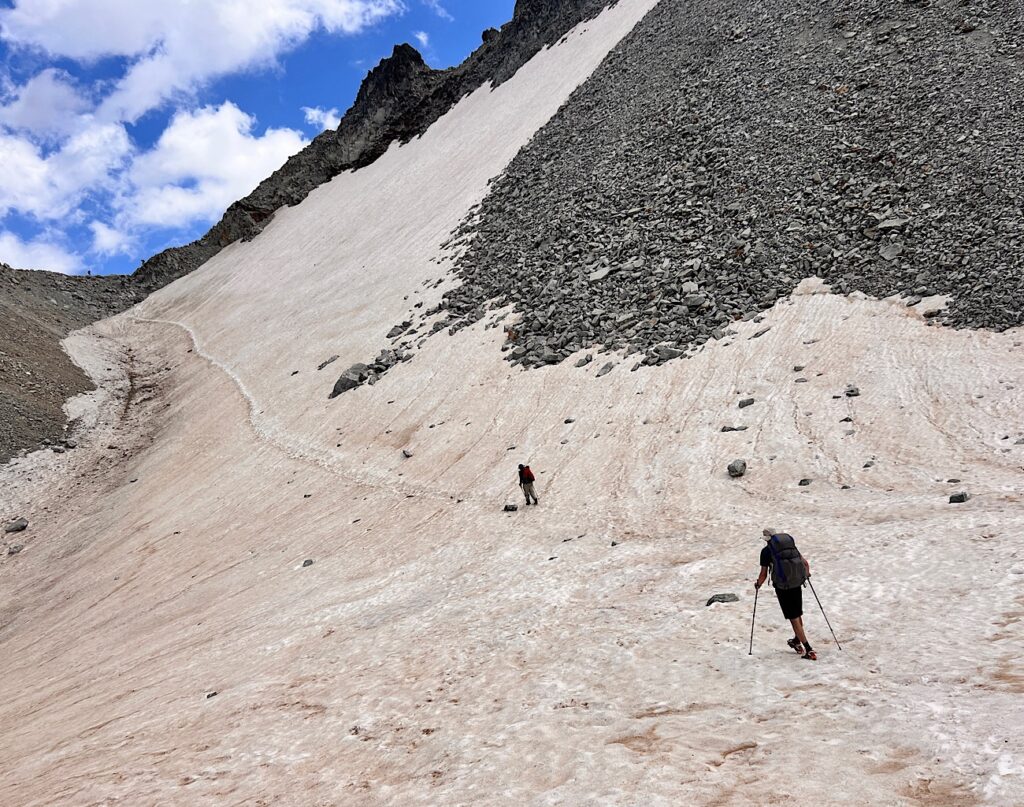
I guess if you were one of these Gryphon Vultures soaring overhead, you might say the Refuge is “right there,” but mere mortals require moving their bodies with feet and legs and this terrain is – you guessed it, a boulder field.
It’s one that goes on seemingly forever. I can still feel them as I lay here, my quads tight and sore, my feet dead tired, my shins cut up and bruised from making a wrong move and smashing my leg directly into the boulder rather than over it.
Of course we get there intact, cursing the guide’s timings which seem way out of whack when the going gets particularly tough.
Portillon is one of the nicest of all I’ve been in. I was even greeted when I arrived. We opt to sit inside out of the intense sun, the six of us now eating. Tamir and I share a massive omelet.
The French end their trip and we continue on with full stomachs, crossing the dam with a view of large icebergs and the massive rock hop we just completed.
Col Inférieur du Literole has nothing to feel inferior about, except not quite as high or impossibly steep as Supérior.
It’s a good pull heading up on full stomachs, burping most of the way, but honestly easy to climb over 400 meters on well marked path plus a bit of snow.



It’s the descent that is an absolute nightmare, at least for me. We make a small, exposed traverse to a nearly wiped out descent. The only way down is to turn around and “downclimb” like a ladder.
But let me tell you, this rock is busted, breaking, cracking away and turning to dust as I come down. Fortunately, Evelina is so calm and collected, she offers advice from below (as she too downclimbs) in good footholds.
Obviously, I don’t die, but that is for sure one for the books. You might be wondering why I didn’t just get on my butt and slide. Way too steep and the slide would leave me with a bunch of broken bones.
Let’s not discuss rocks anymore, shall we?
I reach a bit of “trail” and can face out again slowly finding the steep snow where this time Floris suggests I “embrace the slide.”
I fall a few times, but even steep, the snow is squishy and I can walk and slide a bit to get down this monster.
Have I mentioned yet how much I like walking on snow? Because snow covers the rocks. And when we reach then, it is a long way still to a decent place to camp.
We see nothing at the deep azure lake below the col, nor next to wee lakes within a rock pile.
So our only hope is to keep moving. I still feel strong, but after a certain point, I feel like I’m holding everyone up. The men float on the rocks, and Evelina is more like me and careful. Still I get tired and frustrated needing to strategize each and every step.
It is beautiful in here and the sky is changing with big clouds, so we stay cool most of the afternoon. I take pictures and shuffle along, only once banging my shin.
Then green opens up at Barranco de Remuñe and we work our way down looking for a dry place to pitch. I find the spots, all flat and near each other, one even a kind of luxury suite with a rock wall and rock furniture.

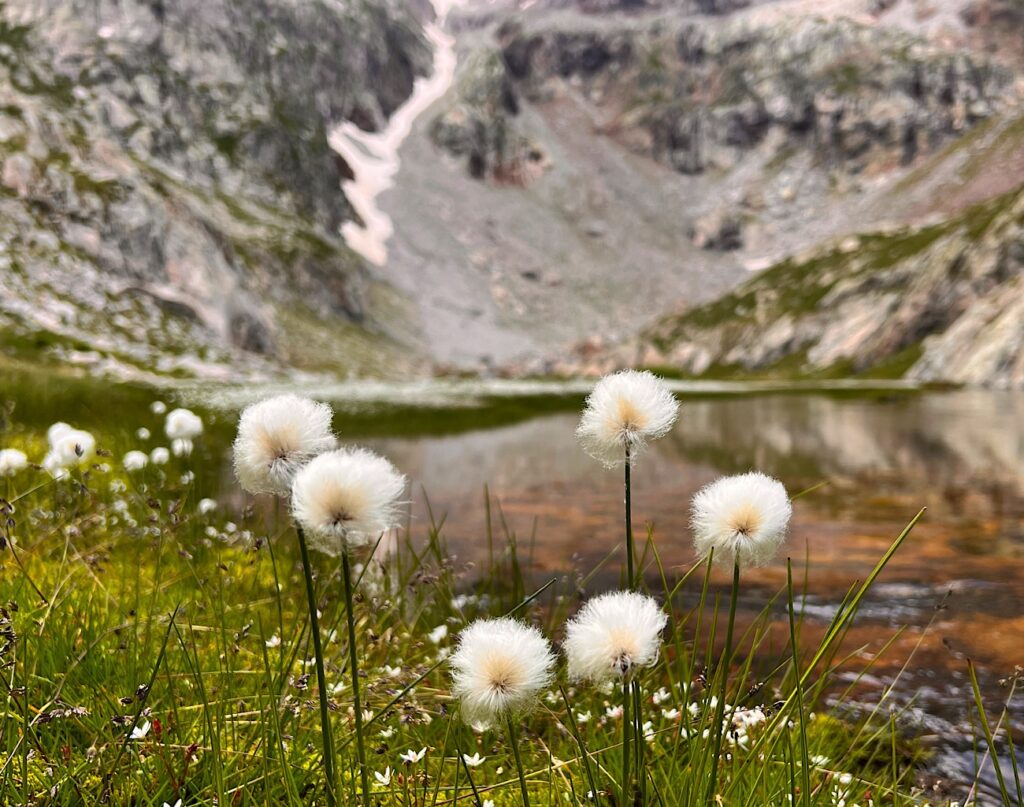
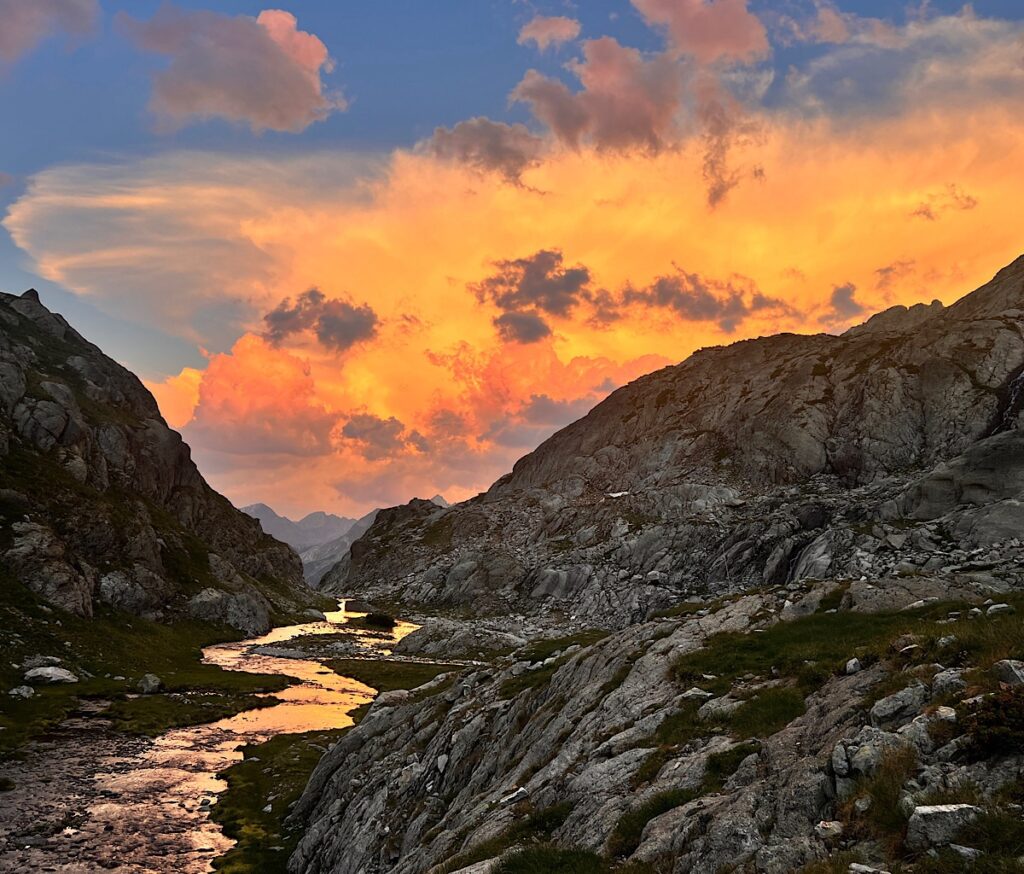
I offer that to the Dutch and we set, clean up in the icy water, eat and plan. Floris suggests we take a short day to a bivouac only four hours away so I can get a bus to Benasque at the upcoming road to shop and we can all rest up.
Rest up, you ask. That’s right, there’s one more hard and scary “E” rated bit where I know I’ll whine and fuss but still get through.
And there’s nobody I’d rather do it with than this crew.
Day Twenty, Remuñe to Plan de d’Aigualluts
Many odd mishaps happened today that were somehow rectified.
The trail provided – as it always seems to do – placing me and my hiking friends on a soft grass island in the middle of the Barranco de Escaleta, a river of glacier melt from the highest peak in the Pyrenees.
Last night as the sun went down, exhausted and beat up but beyond happy with our adventure, I was visited for a small summit by Floris and Tamir.
Floris is an engineer, and it shows in his planning and attention to detail. But he also has the nature of a border collie, shepherding his flock.
Without telling us what to do, he makes a plan that invites us to participate. We’ll walk right past a road where a bus travels to and from the tourist town of Benasque. Also at the road is a hotel with a restaurant.
Since I’m almost out of food for three more days of the section and everyone needs a pause from the wild terrain, he suggests I bus into town and they stay behind to eat everything on the menu, then we’ll all camp somewhere on our way to the next wild section.
I’m so touched he includes me in his planning, so set off early to catch the first bus at 10.
it wouldn’t be the HRP without boulders


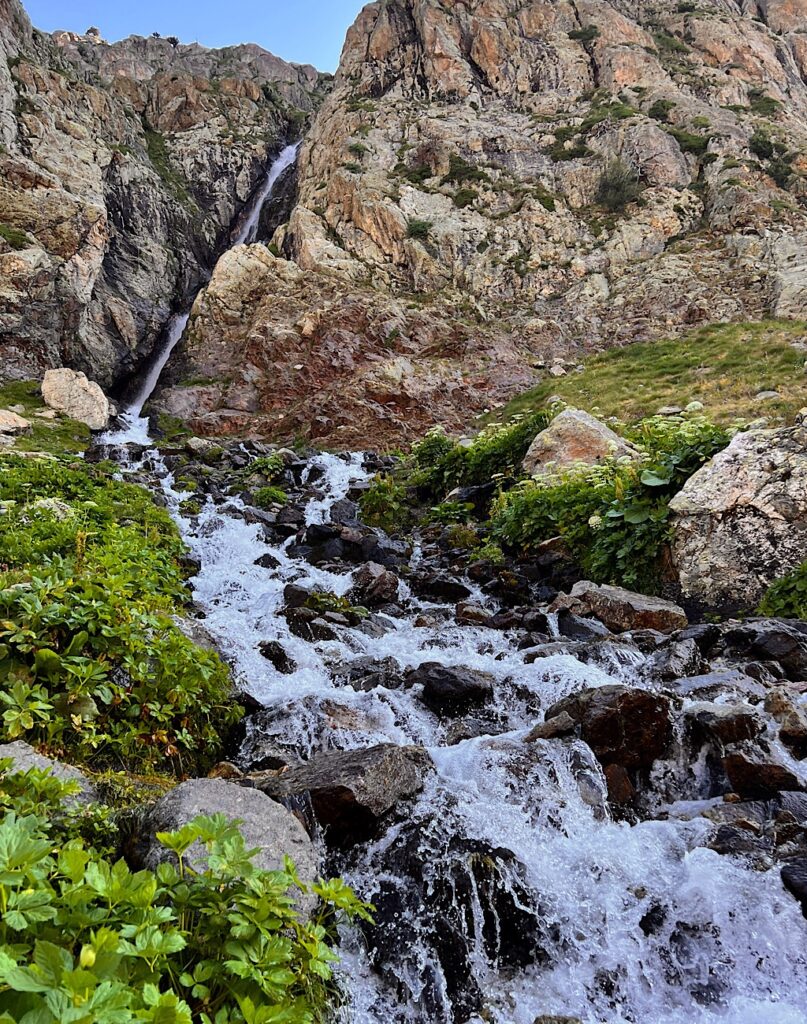
I have all sorts of visions of easy trail through this river valley and think nothing of taking it on alone to get my shopping chores out of the way early in the day.
Boy, am I wrong.
The river cuts less of a valley and more of a gorge with more boulders to negotiate. I take it in stride and am grateful I put most of the rocks in my past.
But then I come to a wall.
The river rages below in a frenzy over boulders while the trail finds its way to an exposed crossing high above. You likely wouldn’t die if you fell, but it would not feel good.
I carefully pack away my sticks and see if by facing the wall, I can slowly feel my way around.
Absolutely not. No way, no how. I’m sure it can be done, but not by me.
I, of course, whine and fret, wondering if I ought to just wait here in this precarious position.
That’s when I notice another way down. It’s a sloppy, eroded mess that drops down to the rapids, but the rocks look passable in not too deep or too steep water.
It helps that I couldn’t care less about getting filthy dirty and ripping a hole in my pants. So I carefully find my way down to the rocks and look for anything dry or at least not covered in slime to cross.
And just like that, I’m through.

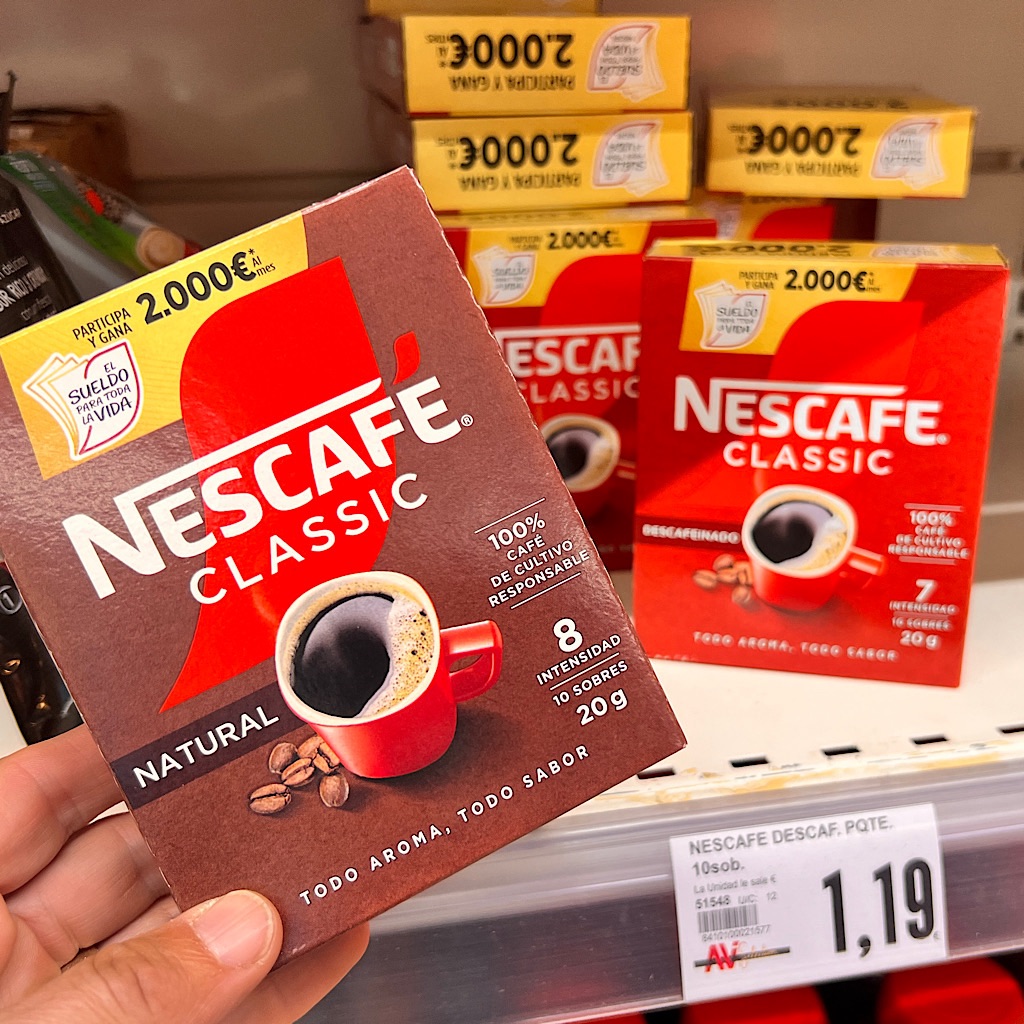
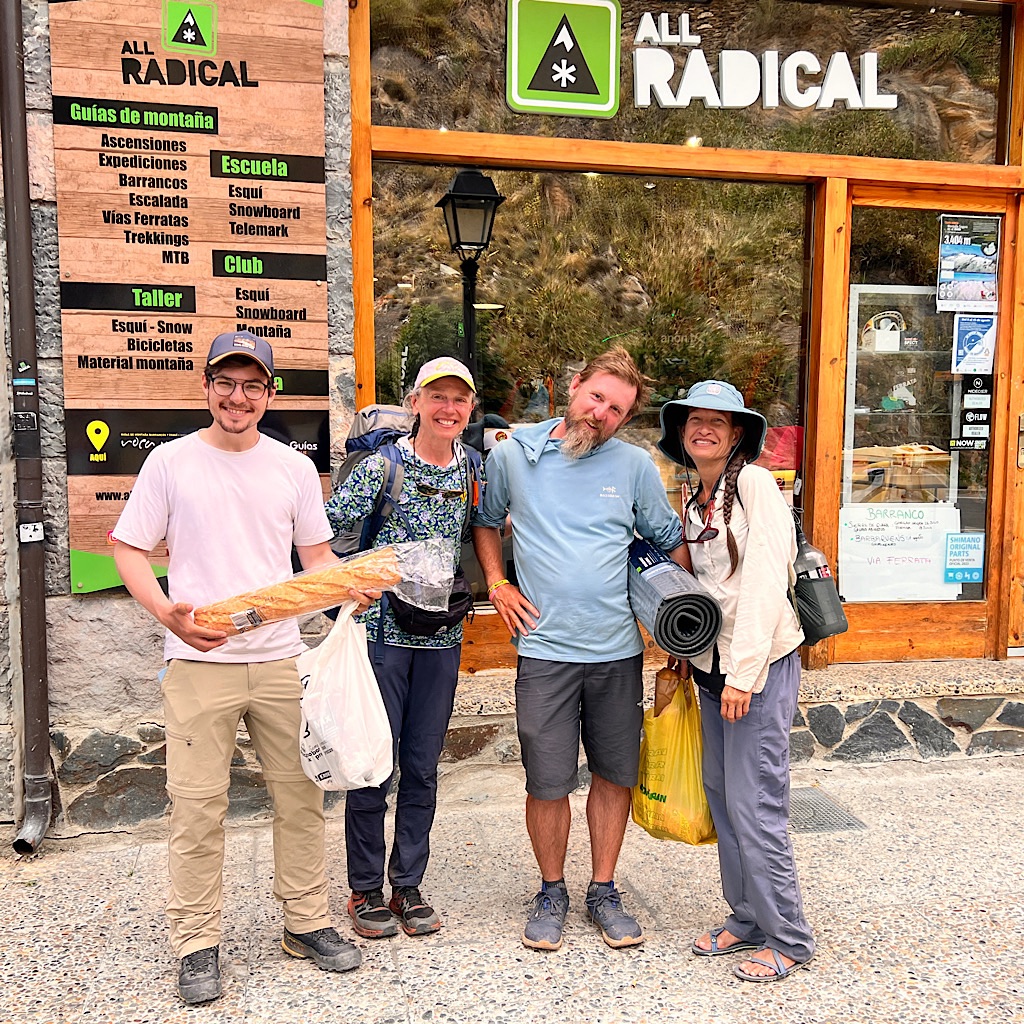
I’ll tell you now that I felt like a wimp finding another way, but when I meet the three later, they tell me it totally freaked them out. Maybe I’m more of s problem solver.
It takes time to move through more boulders and wee ledges that get more wee as I climb higher. But I begin to see other hikers coming up which always surprises me that they seek out this challenging terrain – until I look back and remember how stunningly beautiful this place is.
It’s the price we pay for this ecstatic experience.
Lizards and pine trees and birds, oh my!
Soon, I return to living things like chaffinches and skylarks, plus dozens of lizards, scurrying on rocks so fast, they slip. Perhaps they too embrace the slide.
The day is getting hot and I’m grateful for tree cover, the smell reminding me of the Sierras. Backpackers, trail runners, day hikers in skimpy outfits, ancient people shuffling along – I pass them all coming in to experience what has become my daily life.
When I meet the road, I hightail it to Hospital de Benasque, only to discover I passed the bus stop entirely, and missed the 10 bus.
The next is at 1:30 with a 6:00 return. Yikes!
Just as I make myself at home on one of the picnic tables, the three arrive. I’m rightfully annoyed the guidebook didn’t offer clear directions, but it gives us time to bond – and eat, a hobby we’ve become quite skilled at.
Stone Village


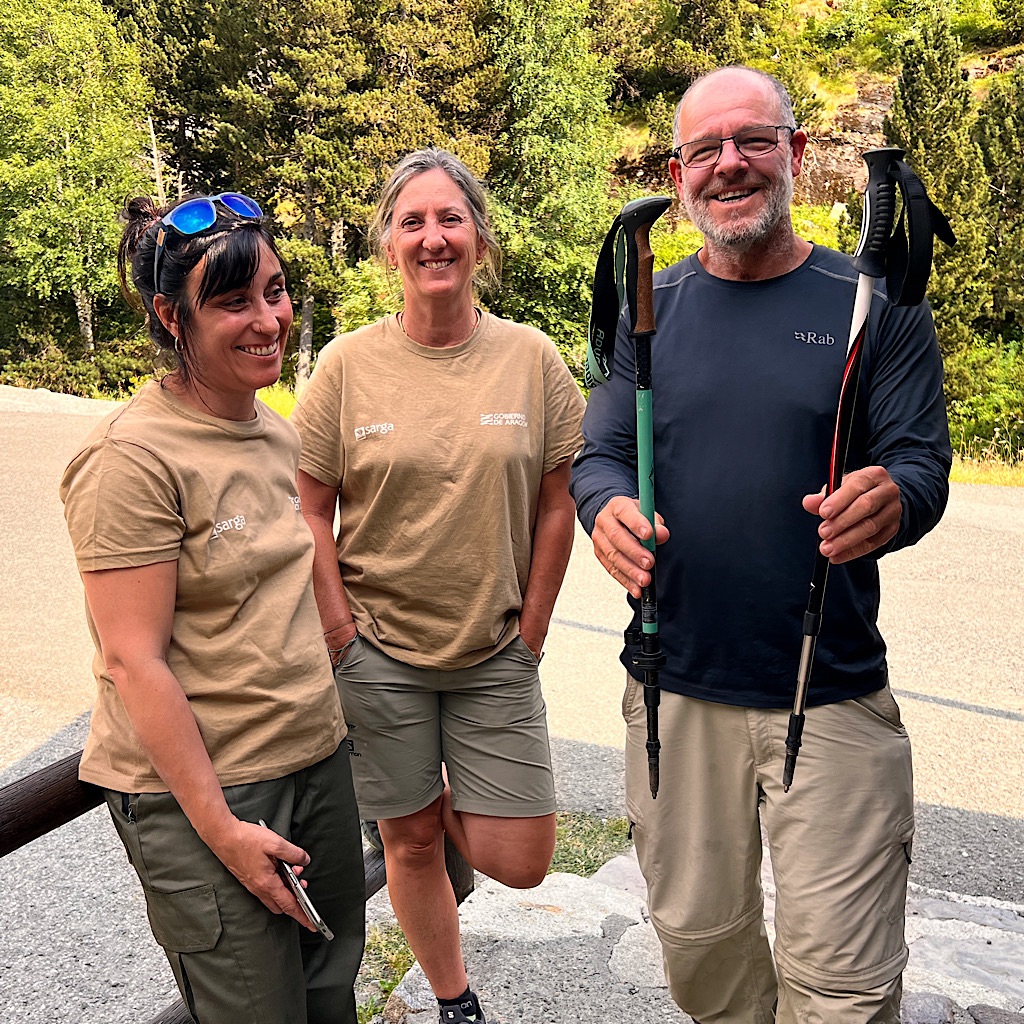
Tamir joins me for the trip down the mountain to the lovely little town of meticulously cared for stone buildings.
I should point out here that this convenience is totally absent on the upcoming section with only one tiny village in the middle. The luxury of big meals at refuges and walking through towns will be coming to an end and I’ll need to adjust.
It’s very hot in town, but we find shade, the supermercado, even a lovely church where I thank the spirit for safe passage.
After yet another sandwich, we decide to head back before 6 and stick our thumbs out. It takes a few rejects, but Tamir urges me to “trust existence,” and the next car offers us a ride.
He plays ZZ Top all the way back up, then breaks the news that we can only go as far as the parking lot because the upper section is in the park and only open to busses.
It’s about a 10 minute drive further but more than an hour of hot hiking through meadows between the lot and La Besurta, the only section I’ve allowed myself for expediency’s sake to skip.
The Trail Provides
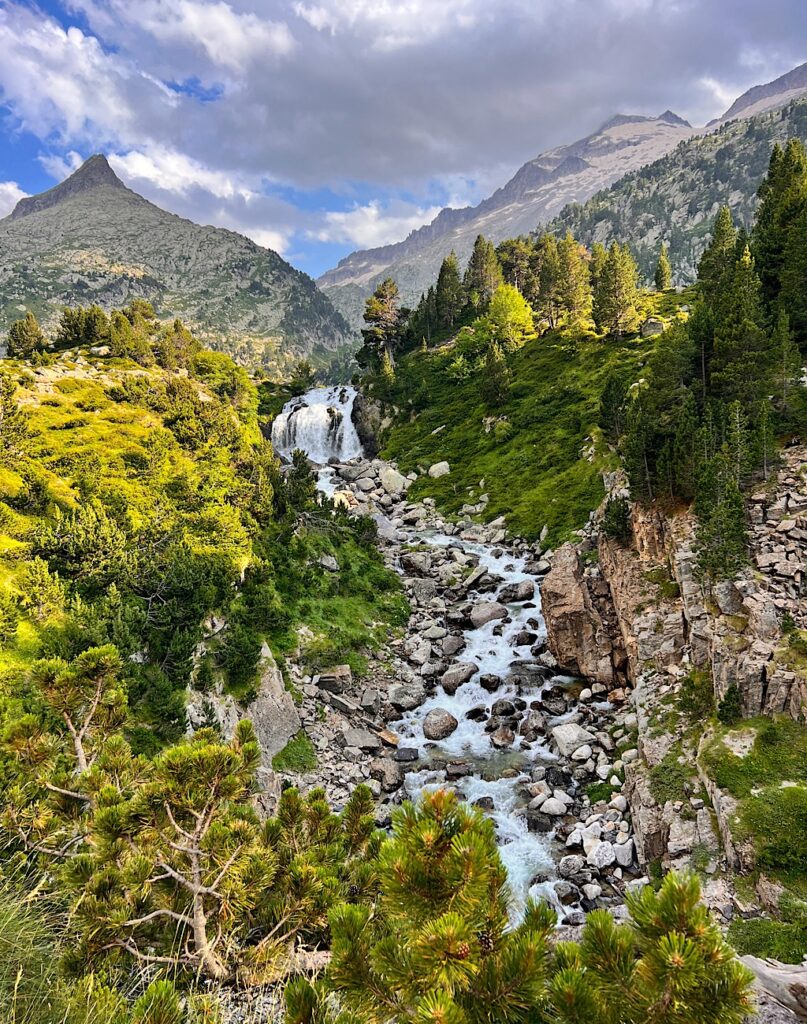
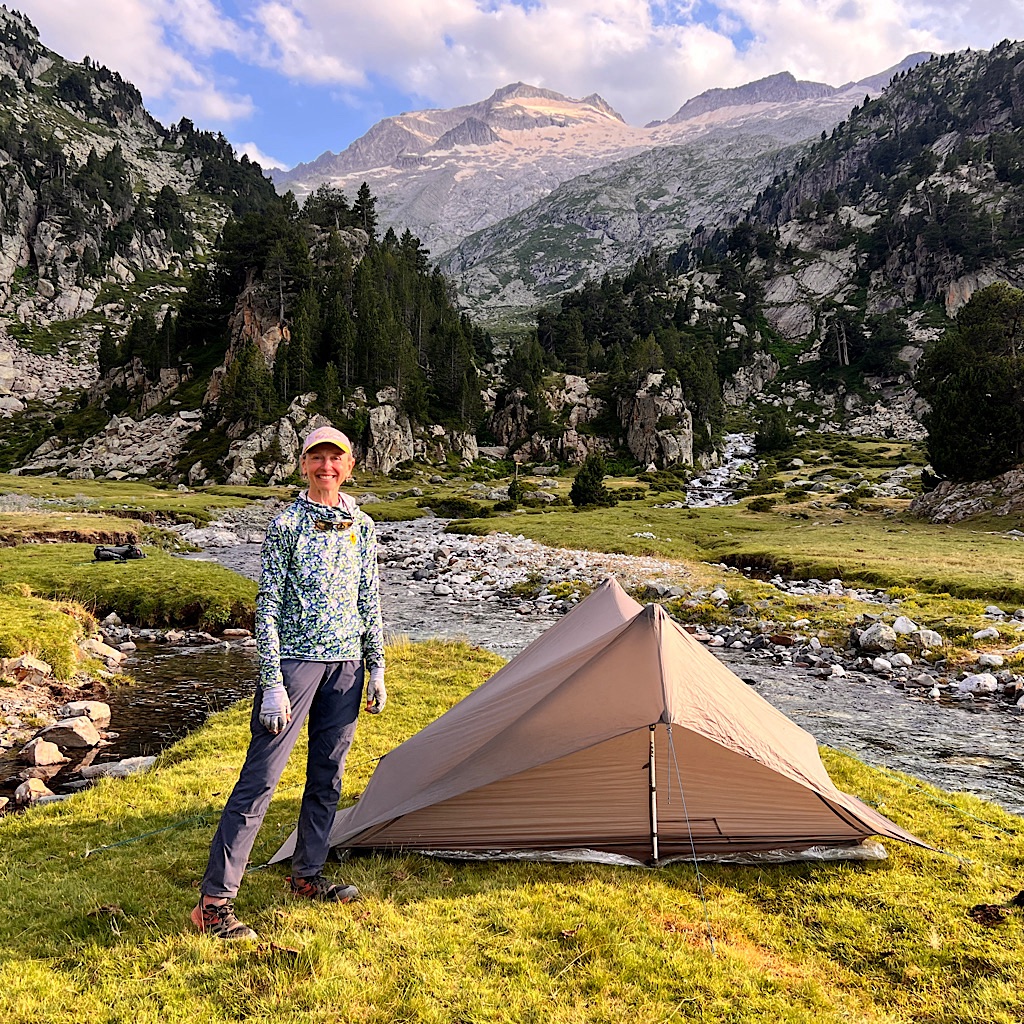
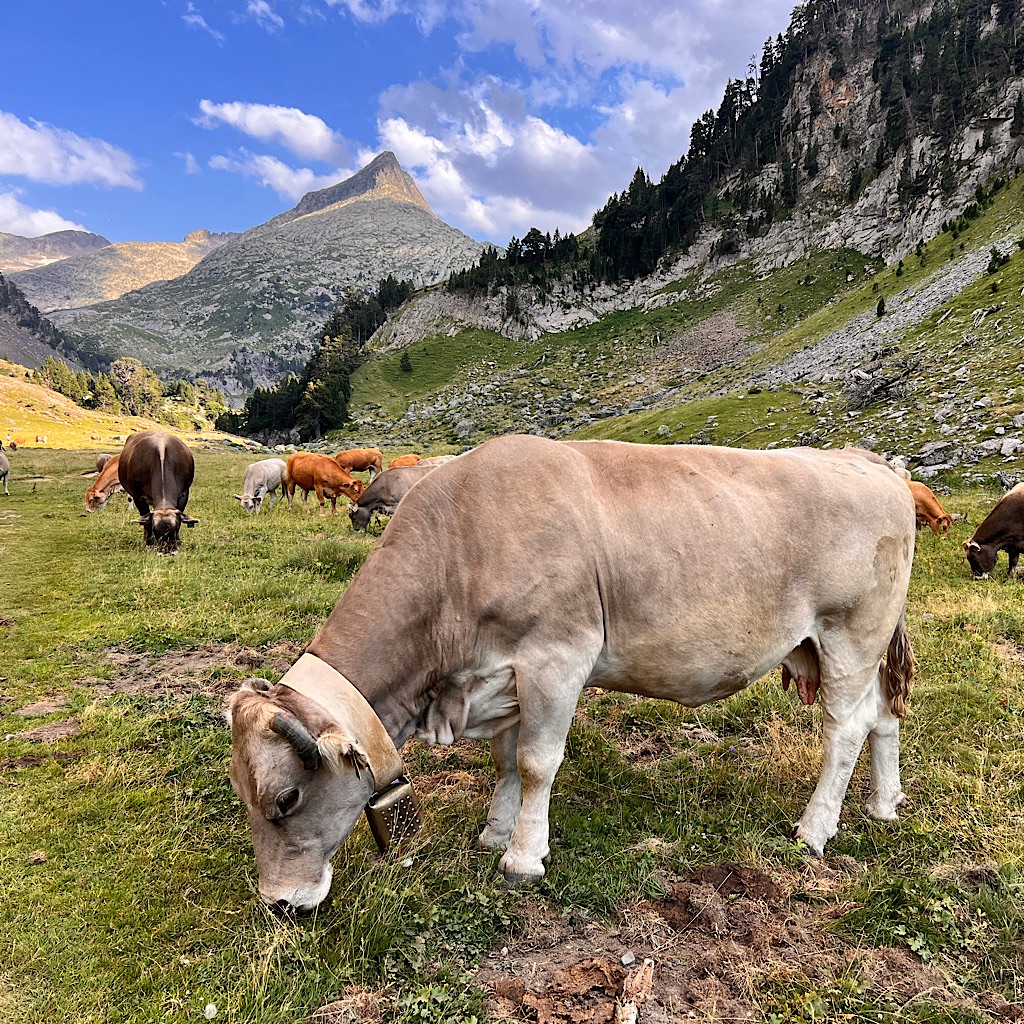
But now we have to wait for the bus, which is very casual about timetables. Again, I’m a bit annoyed this wasn’t made clear, and not entirely sure if our friends will want to wait for us.
As we sit in the shade, I ask Tamir where his trekking poles are. Oh no! He left them at the cafe!
Like me, he really needs them to walk, but maybe more important, he sets his tent with his poles, so they are absolutely vital.
Right here, at the lot and bus stop, is a small hut for the park. Two women run things, handing out maps and advice. Tamir had already started up a conversation with them about the bus timing and his plans for hiking. So when he realizes his sticks are gone, they pull out a passal of poles left behind but absentminded hikers.
And he’s saved!
Funny how the universe balances since his poles will likely find a new home on some needy hiker’s wrists, so all is well.
The bus is packed with hikers, all staying at the refuge to climb Aneto, while we embark on another hike into a beautiful new aspect of the Pyrenees, including a waterfall that empties into a deep hole, where the water simply disappears plus hundreds of cows, their bells clanging as they munch deep into the evening.
Day Twenty-One, Plan de d’Aigualluts to Lac Tòrt de Rius

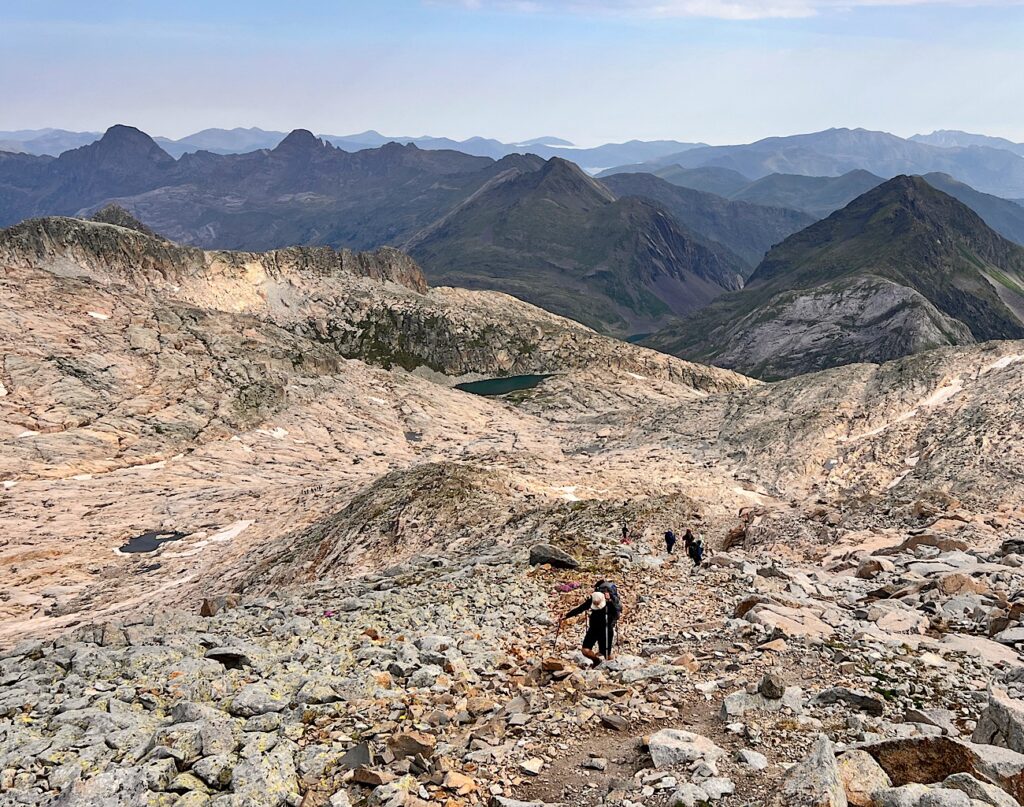
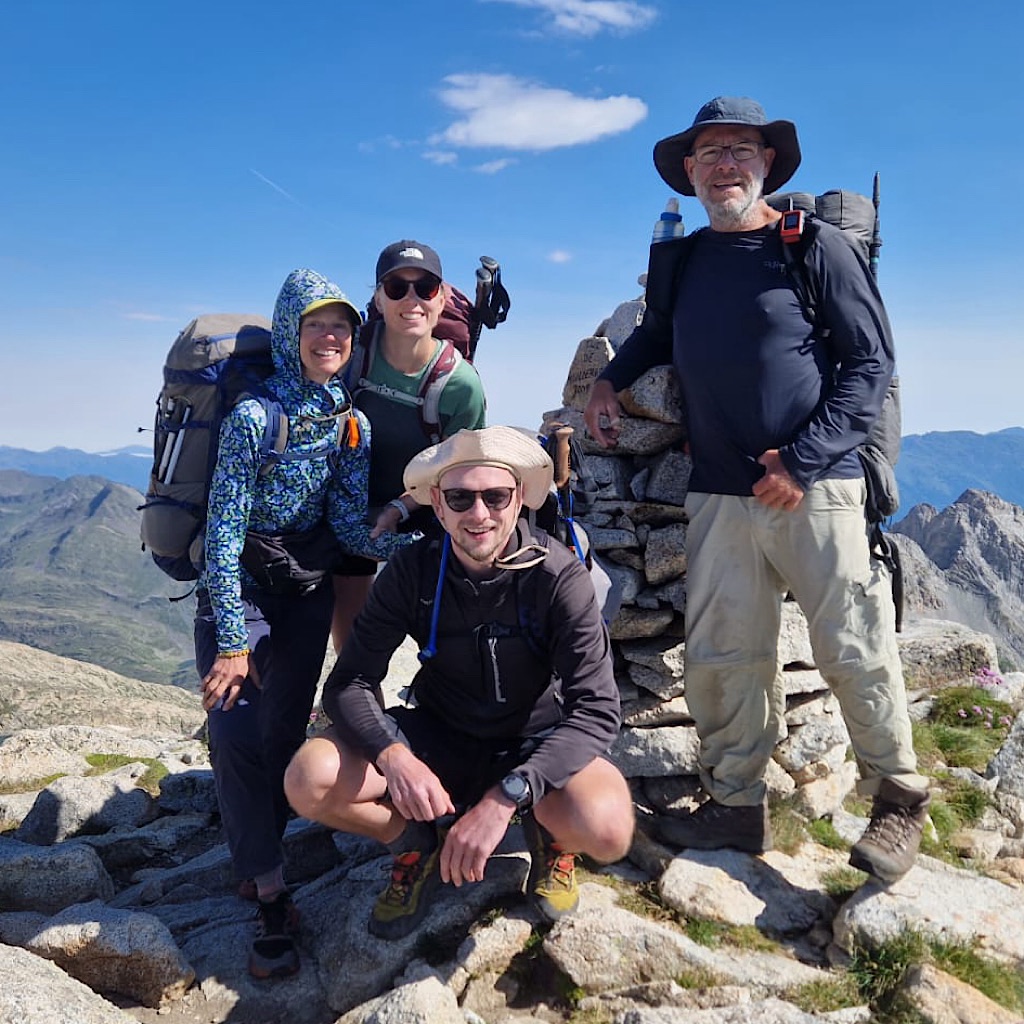
“this is not hiking”
There’s a PCT thru-hiker on the HRP right now who has made the comment that this kind of high-level, boulder-hopping and scrambling with over 5,000 feet of ascent and descent is not really hiking.
True, it’s not marching along only using two feet and “crushing miles.”
There are four days on the HRP rated “Exceptional.” These can – and do – have dangerous exposure and often require the use of your hands, plus always good weather.
The guide offers easier alternatives with more marching and less exposure and, needless to say, the PCTer took those.
But I lucked out on weather and on hiking pals, and took on all four – one of them, completely alone.
“the first meters require great care”
I have been freaking out about the Col de Mulleres ever since I decided to walk the HRP. In my guidebook, I’ve written “scary” because every hiker blog I’ve read describes it as wildly out of their comfort zone.
The truth is the drop is straight down for about 20 meters, but with bomber feet and hand holds – and all on granite, about the strongest rock you could hope for. (in contrast, the fearsome drop from the Literole is on crumbling limestone, breaking off as I descended)
It’s dangerous as heck crossing over that thin wisp of a bouldery ridge at the Col then dropping down something that most definitely is not hiking.
What it requires is for the hiker to turn around and downclimb, sort of like coming down a rocky, uneven, traversable ladder.
I would not say what I did was pretty or without yelps and confusion, but it was way easier to manage than I’d expected or was prepared for from other hiker’s descriptions.
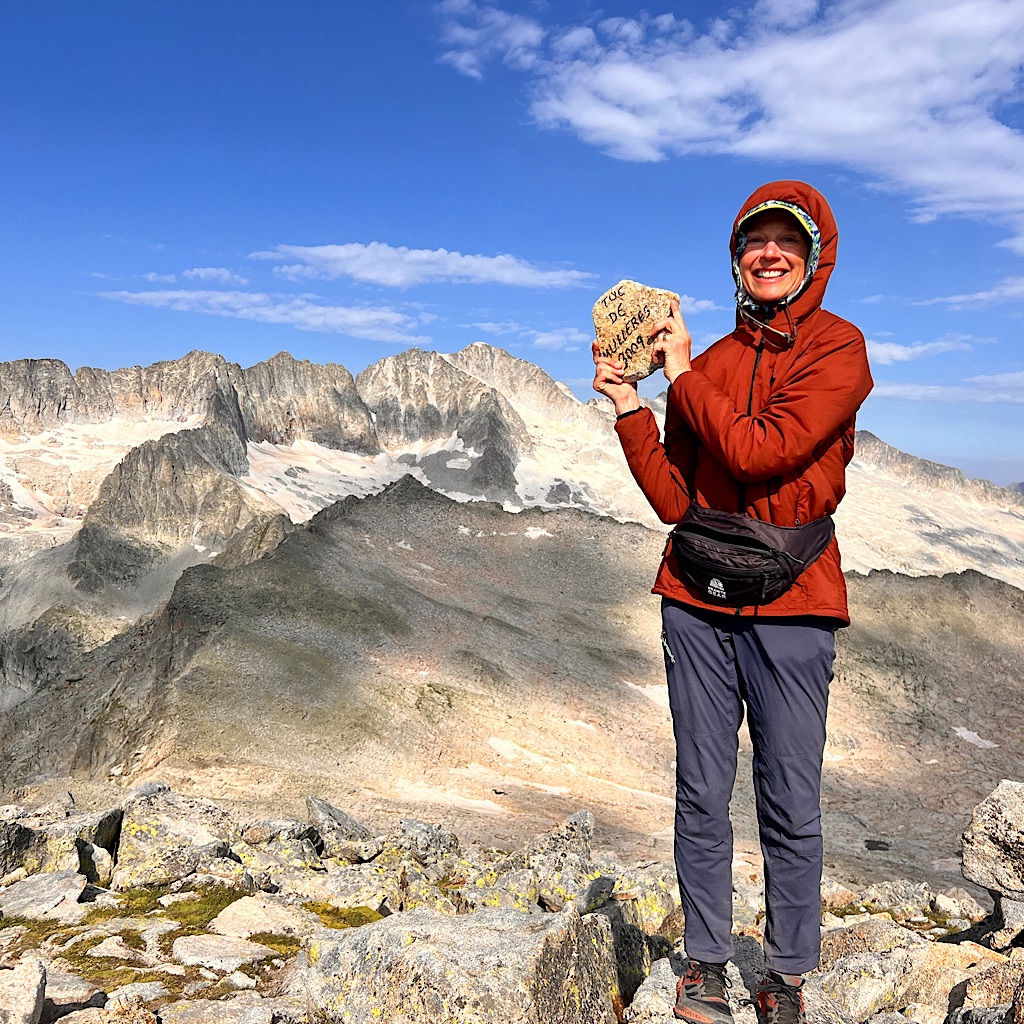
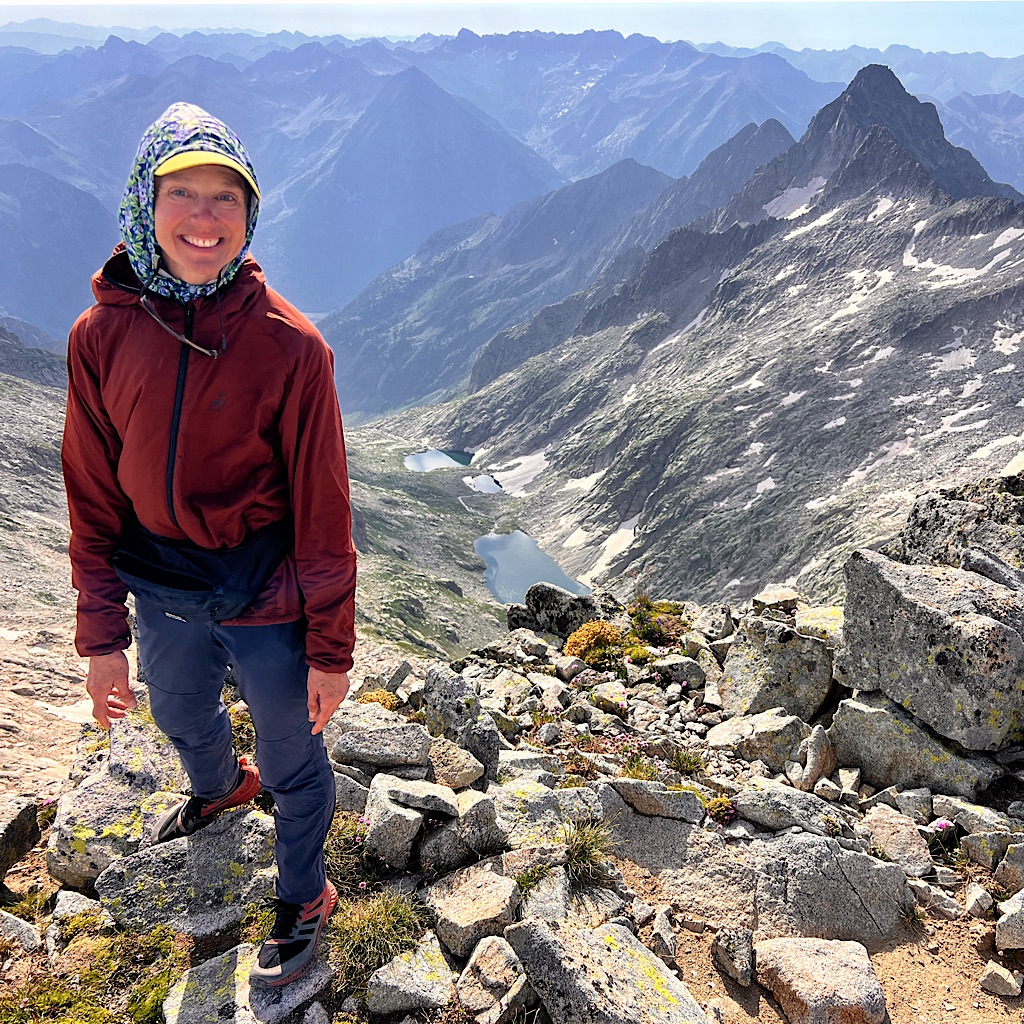

cowbells and terror
I did not sleep well in our Eden the night previous to the last of the E-rated hikes. The cows donged all night long and I kept having visions of wiping out on the Col, being called a “stupid, unprepared American,” what is an old lady like that doing on a pass this technical?!?
Truth is, I had no idea what I was in for, so could only imagine I’d freeze up completely and would have to return, embarrassed and ashamed.
So, I got up panicky in the morning as if I’d overslept and almost lit the tent on fire when I tipped over my coffee on the cookstove.
I packed up soaking wet, then hightailed to the trail concerned I was behind or holding up the group.
As I started the long ascent, I noticed a group of 12 hikers in a long line following me. It can’t be that hard if so many people do it, I thought, only to learn later that they’re just bagging the Tuc (peak) and heading back the same way with no interest in the real technical stuff.
Right away, there’s some boulder scrambles, warming me up for what’s to come and challenging my balance.
Note: If you are reading this with an intention to try it for yourself, take some rock climbing classes as well as yoga for balance and strength.
But soon, we’re on long slabs of polished granite. It’s beautiful and sticky, and as easy to ascend as snow. The morning is cloudy and gray, not heating up yet once we meet boulders to negotiate up to the Tuc.
It feels good to bag another peak looking straight at the highest, Aneto and down deep into the lake-dotted valley we’ll descend (if i can get through the col)
Tamir takes my coffee and boils water for the four of us on this lovely, windswept summit. Our last drink, as it were, before doing the thing we’ve all anticipated.
We actually can see the backside from here and people pop through easy enough.
We all ceremoniously pack away our trekking poles and scramble down the boulders to our starring role on the col. A number of trail runners hang around, unphased and chill.
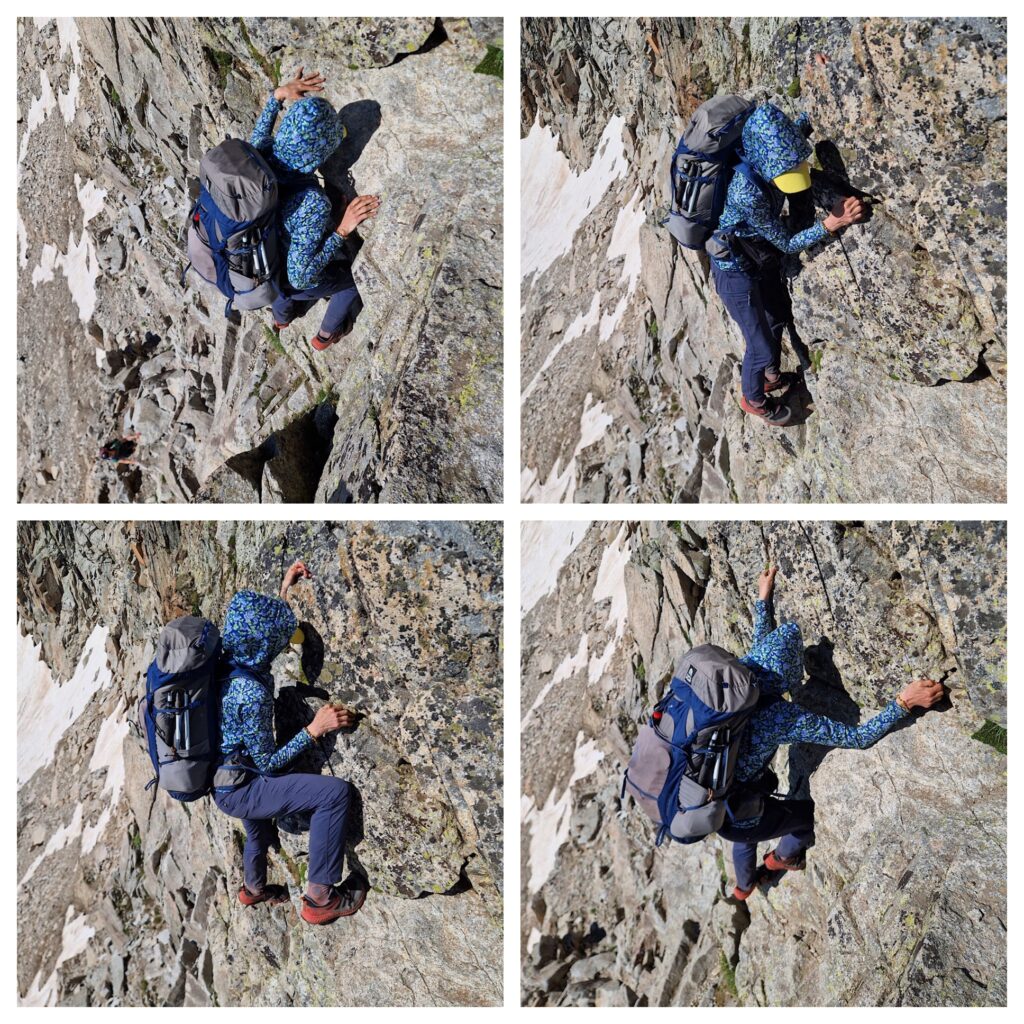
“the descent is mandatory”
American climber Ed Viesters used to say the summit is optional but the descent is mandatory. It’s all about mindset, not letting sunk cost fallacy get in the way of surviving.
But it also explains how hard summitting is when the descent can be harder in many ways – crashing down on tired knees, the elation is gone and the day is heating up, your body is safer ascending because your position makes injury less likely while descending is essentially controlled falling.
Once all four of us are safely down the 20 meters of so requiring downclimbing, the teasing begins. Oh, let’s be honest, the teasing starts the second I make my first move.
“What do I do now?!?”
“Zigzag.”
“Grow longer legs.”
“Go down.”
“Don’t die!”
As I said, I am lucky to have met this group. We laugh and help each other. I never could have done it alone.
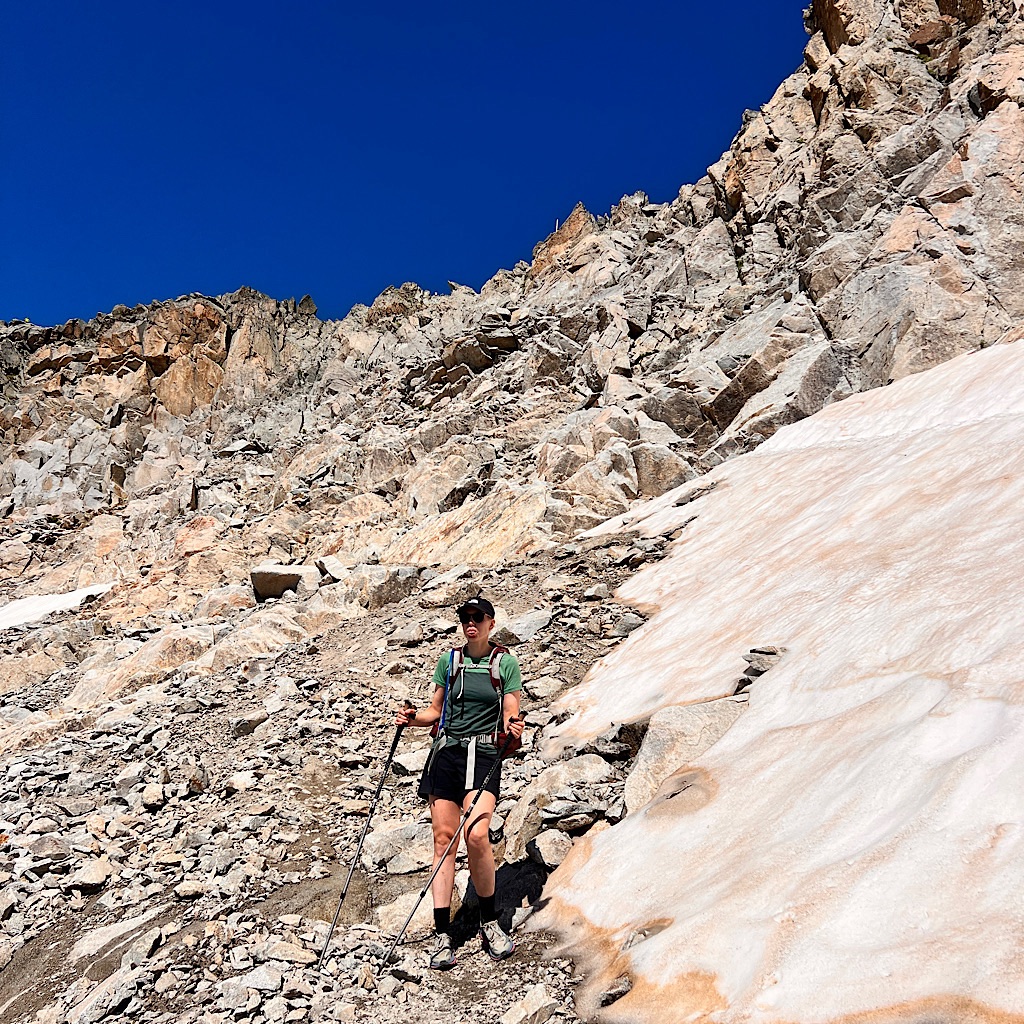


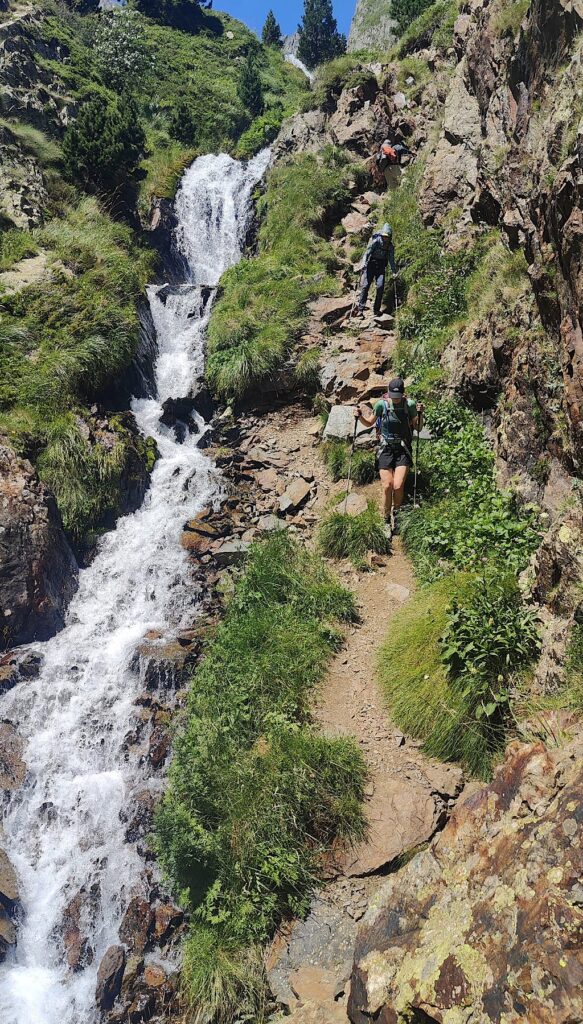
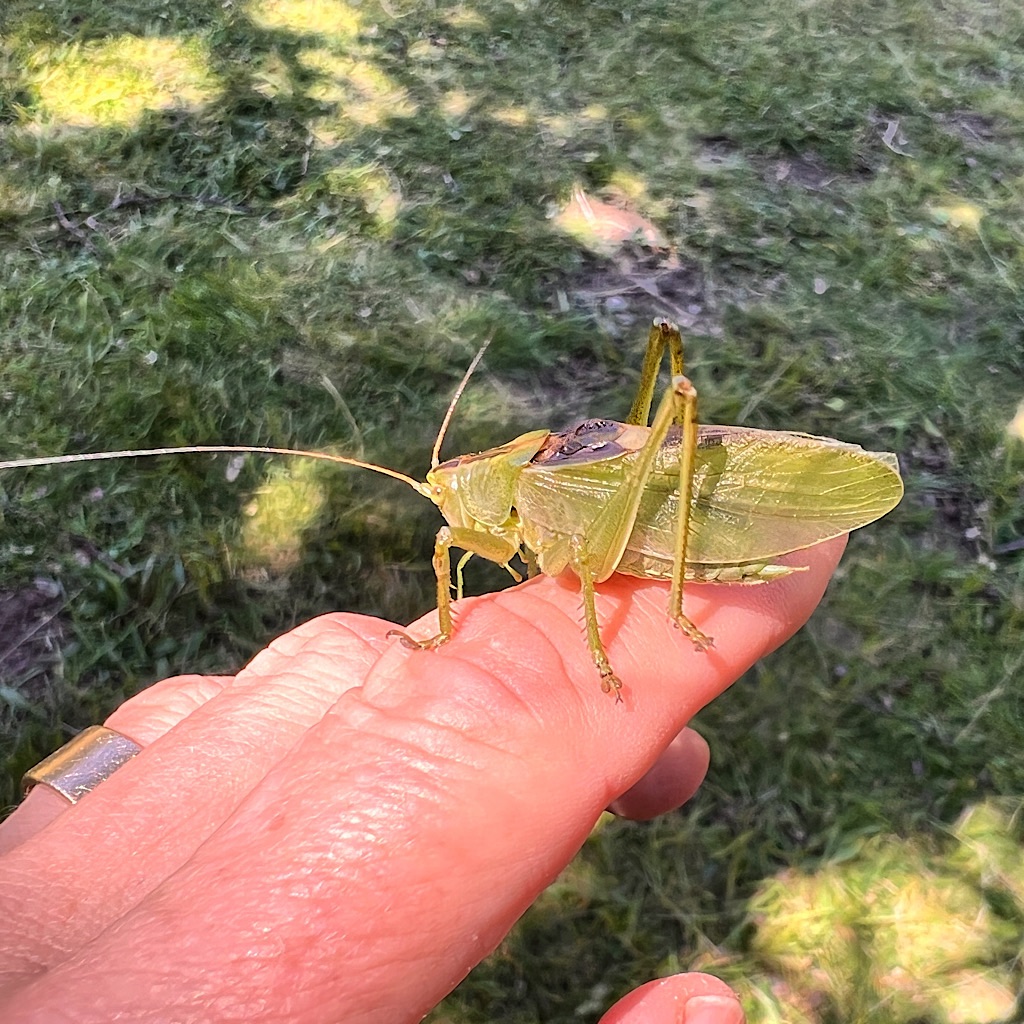


The excitement passes quickly and then it’s a very long descent to the bottom. There are boulders and loose scree, so much steep trail, no shade and merciless sun.
We do have a wild waterfall right next to the trail, and a funny section with a rope for safety which was a snap.
I should mention here that at one point at the col, I traversed a bare rocky ledge with superb handholds. You get a better grip leaning back, and that felt amazing to be in such control.
In fact, many of the awful rocky bits that felt like I’d wipe out if I dared take them on as steps, I’d turn around instead and use my hands to go down backwards, always with much more control.
The lakes, the waterfalls, a whole meadow of wildflowers and crickets, then a dip in the river made the descent manageable.
But it left us at a tunnel entrance connecting Spain to France, and not one concession amongst derelict buildings. We rest in the shade for an hour, then decide to climb (again!) for two hours – in the heat, to a set of lakes.
Camping is forbidden, but seems to be tolerated if done quietly, so we join the GR11 here and begin heading up, first through beech trees, then pine, then grass and a sea of sheep.
We’re all exhausted, but strong and determined. 700 meters ascent, y’all, after climbing Mulleres. I hooked up with a tough bunch, and they tell me I move fast on those ups.


We cross the Port de Ruis and see a couple already setting up. The lake is very windy and one Dutch guy finds room behind a rock wall. Tamir is not fast on uphills – though a fearless Mountain Man flying down in any condition.
He is cooked and stays with the Dutchman, while us three go on, my strong legs that got me this far on killer hard terrain just about cooked.
At Tort de Rius, all the way around the first lake with a tiny bit more climb, we find perfect spots. The lake is surrounded by granite peaks and is filled with islands and exposed rock, like Yosemite.
We enjoy it briefly as the sun goes down behind the mountain we just climbed and our enormous descent. Then make dinner and fall deeply asleep, only the sound of a very light wind this night’s sandman.
Dat Twenty-two, Tort de Rius to Estany de les Monges
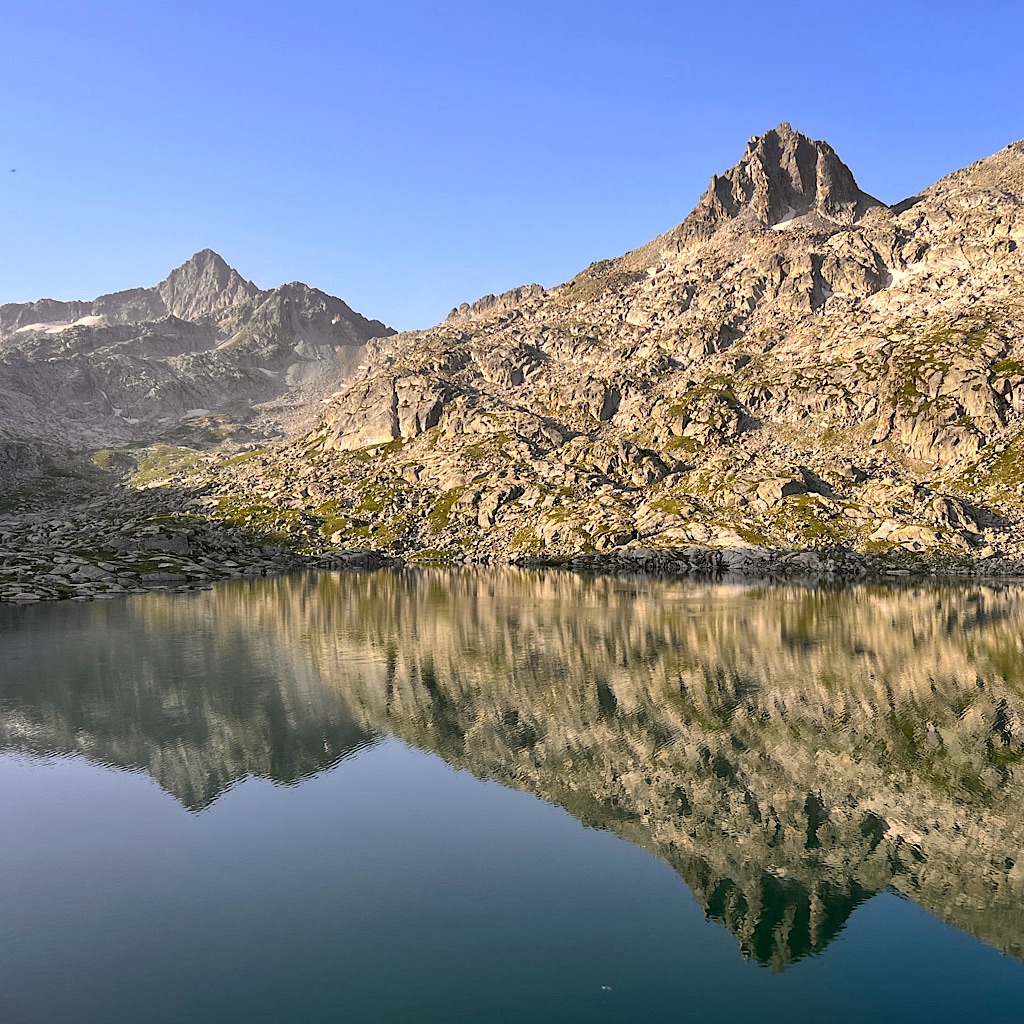


We’re tucked in again next to a Lake. Yes, we are completely breaking regulations setting here at Estany de les Monges because this is the Parc national, but tents were set after the sun set and we’ll be out before light, so…
No camping allowed but definitely grazing allowed as cows with deep-toned bells kept looking over eagerly at our patch of grass where we squatted in the afternoon.
Such pretty, inquisitive faces withe long eyelashes and sweet snouts. But they sure are loud and poop everywhere, so Floris corrals them over a small rise to another equally tasty patch of grass.
I see – and hear – this happening from high up on a mountain above.
The guidebook tells me climbing Montardo d’Aran at dawn is “one of the finest experiences a Pyrenean hiker can have.” Since a dawn climb would make tomorrow’s walk to Salardú, and the end of this section, a bit too much, I decide a sunset summit will have to be as fine.
And what a cap to the day!
It’s hazy when we wake and I try to get up over the col to Lac de Mar before the sun hits me full on.
Still, though, lovely past small lagoons nestled in granite and I soon climb up, keeping in mind the coming descent is eroded and difficult. The lake gleams just there, but my eyes are fully focused on getting down in one piece.
I use my poles for balance and guidance, and must have leaned in too much in a rock because the next time I pick them up, they’re shattered, cracked in half without hope of repair.
They had a good run getting me safely from end-to-end on the PCT plus many other long hikes, but have you ever tried to hike in such terrain with only one pole? I guess it’s better than zero.
Floris offers his to set my tent and it’s just a day left to a rest day and shopping, so I make do.


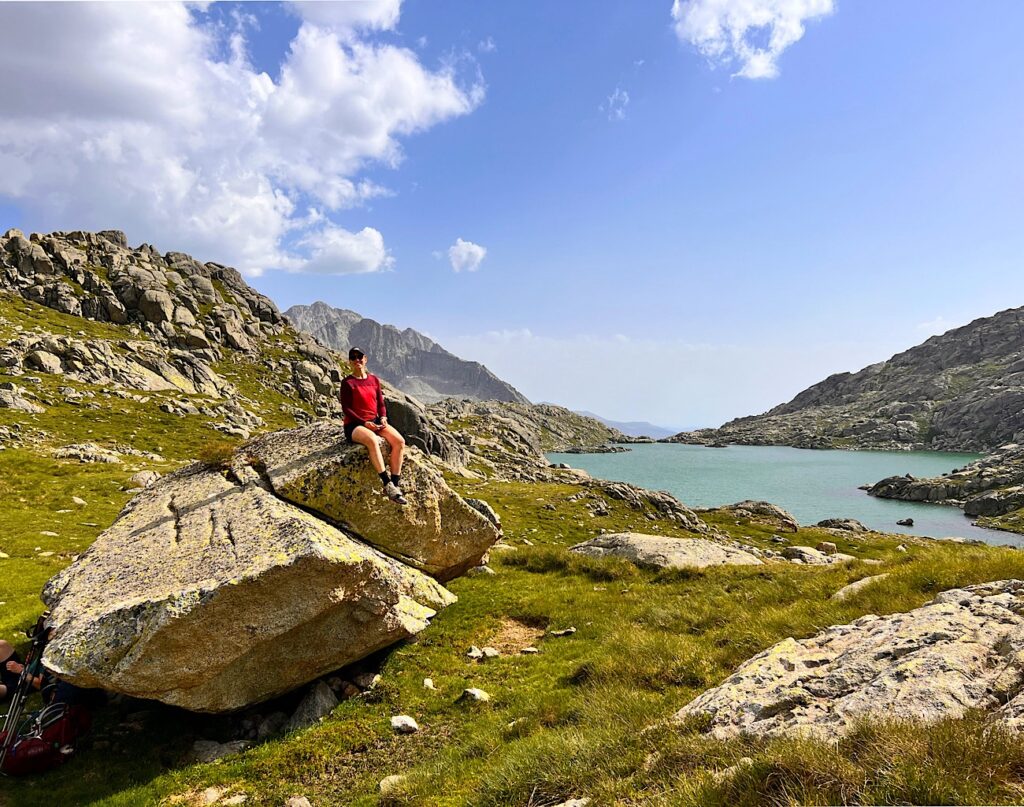
But funny how this trail works. The guidebook focuses on one tricky part, leaving you to assume the rest which just fly. Instead, walking along the shore of this lake is a boulder fest of balance and placing each foot like a ballerina – now with just a single pole.
It’s also getting hot, the haze likely a result of extreme temperatures in Southwestern Europe. I move as best as I can, willing myself never to fall.
And at last, a reprieve! Switchbacks seemingly built with tiles all the way down to a valley Refugi de la Restanca sits awaiting hungry hikers.
It is lovely in here – pine trees, wildflowers, crickets, waterfalls – but my focus is on getting down in shade. Easy enough as I triumphantly cross a bridge only to be directed to another bit of descent – good lord, on crumbling, rocky, sand and “too bad for you, Miss One Pole” kind of terrain.
One last indignity and I swear people are watching me laughing as I stumble in.
I’ll miss this service in the next section which is far more remote without as many “manned” refuges, meaning hot meals and a place to sit.
We while away a few hours, then climb steeply up again to cross another port (pass) into our illegal camping.

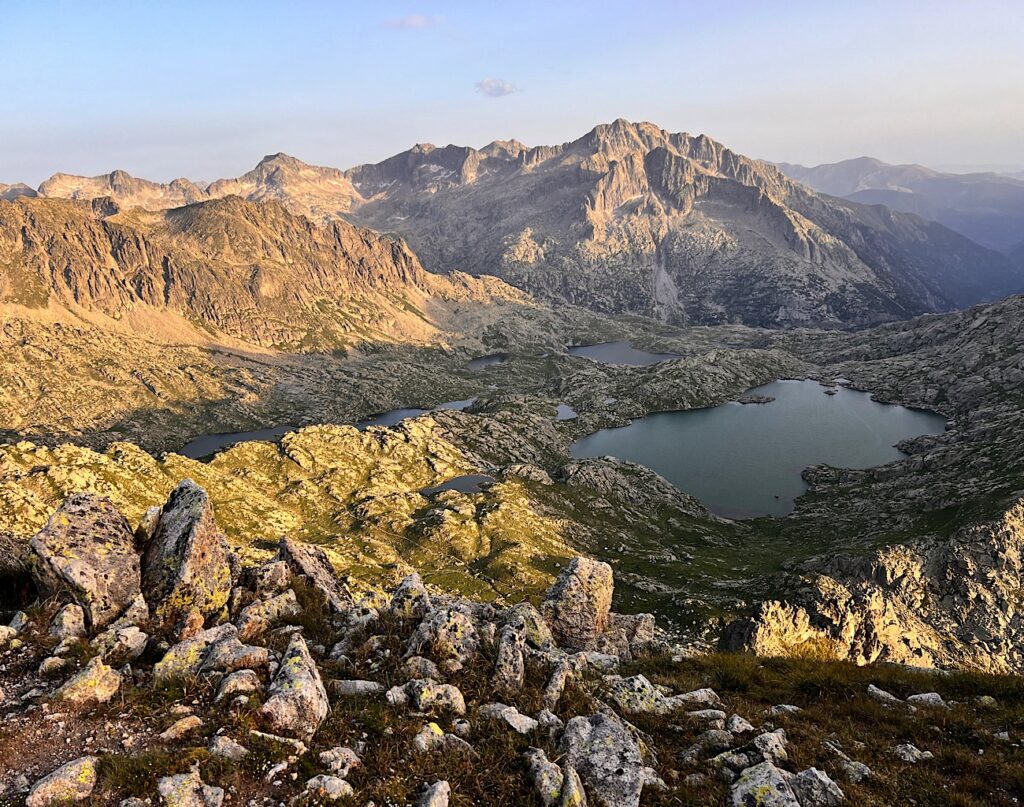

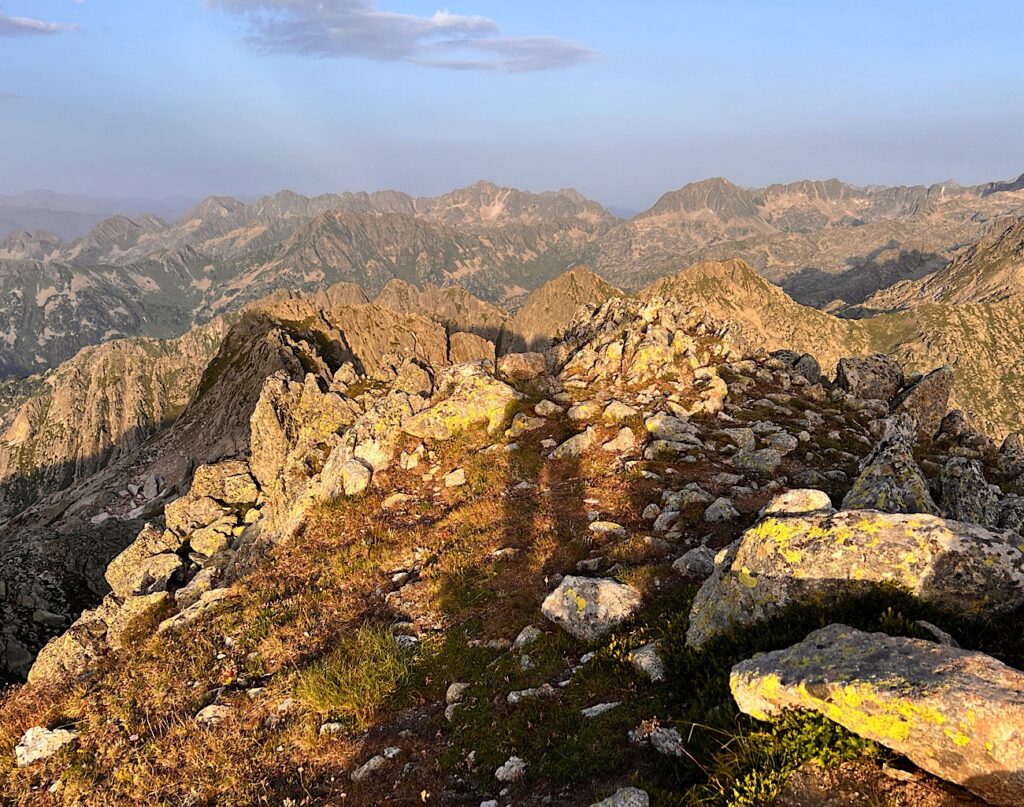
No one is interested in the summit. I’m not precisely sure why it’s important to me, only that I really like going up and seeing the scenery from above.
I’ve hit several peaks, three off-trail which required intention and extra time, and always it was exciting. Evelein loans me her sticks so I have two, and it’s a good thing because it’s steep and rocky.
I start at 7:30 and plan just an hour before turning around. Without a pack, it’s easy climbing and I’m up in half the time suggested.
There’s a lump that’s the high peak, plus a jaggedy petit peak. I get the lump first, and spot on, the 360-degree view is astounding of the Catalonian Pyrenees and many ranges.
Not a soul is up here and there’s something magical about my feet on this place, so grounded and natural.
And just at that moment, I notice a bird up there, holding herself perfectly still in midair.
She’s defying gravity for sure, but also tipped just so to defy the force of the wind.
Why is she doing this?
Not hunting, I don’t think.
Certainly not traveling anywhere.
I like to think she’s doing it simply because she could – and it felt good.
The same reason I added another climb to an already long day – because my legs can take me to go and see.
It’s the most freeing and alive feeling one can have.
I take pictures and breathe it in as the sun inches closer to the horizon. Then traverse to the petit peak.
This rock is metamorphic, broken into long spikes. I’m well protected if I stay on my side of the ridge, looking down to the lake where I see the tents now set – and the cows happily in their new meadow.
Oh, what bliss! What joy to be here. I am so glad I went, even when Tamir said he felt too old for another climb and how brave I was to go by myself.
I guess being by myself ups the ante (I took my PLB for safety) but it also makes the experience – the decision, the effort, the collection of feelings – all mine.
The mountains are still in a bit of haze, but it’s magical so high taking in this foreign land I’ve made my own for a mere three weeks.
It’s 8:30, so time to descend before it’s too dark to see. It’s steep and I move carefully, the tents always in site and getting bigger as I get closer.
Everyone is tucked in, though Evelein asks if it was spiritual.
Yes, it was. And you know, I’m not even tired after that walk.
Day Twenty-three, Estany de les Monges to Salardú
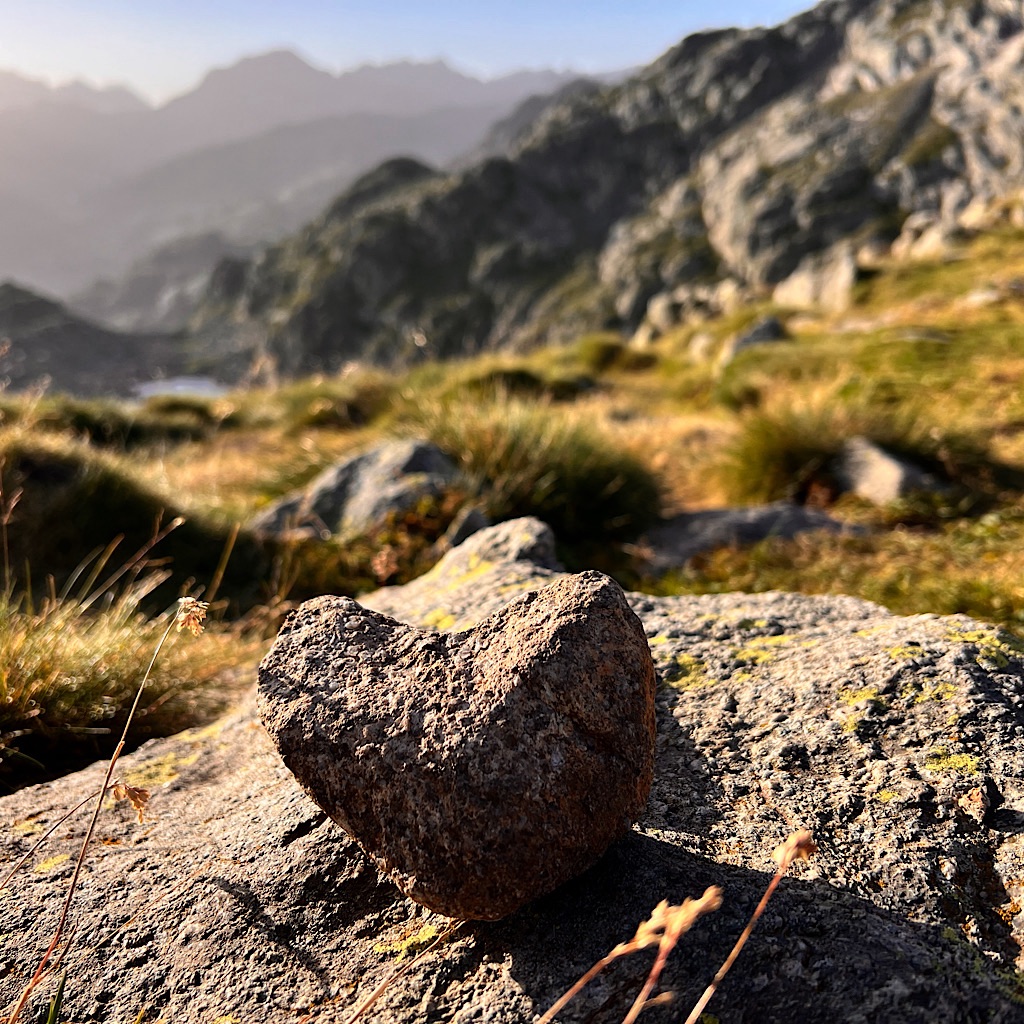
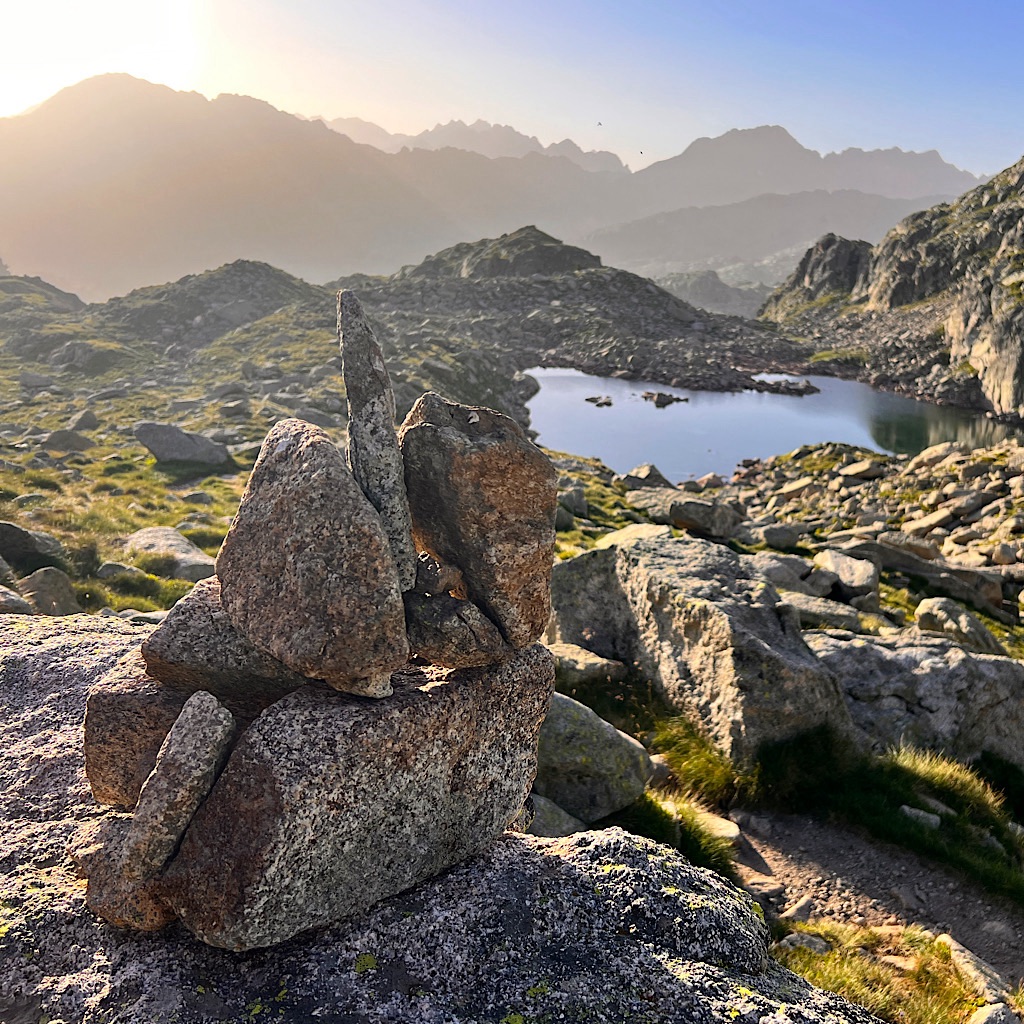
When morning comes, I’m delighted I took a sunset summit. This is partly because we have to pack fast and get moving before we’re detected, but also because a long, hot walk awaits.
I just want to stare here that I respect rules and am a LNT (leave no trace) adherent.
But not only is it awkward to be forbidden to camp, it also makes no ecological sense with cows polluting the meadows.
I won’t take a stand on the subject, but being undetectable and leaving absolutely no evidence I slept in the Parc national seems adequate.

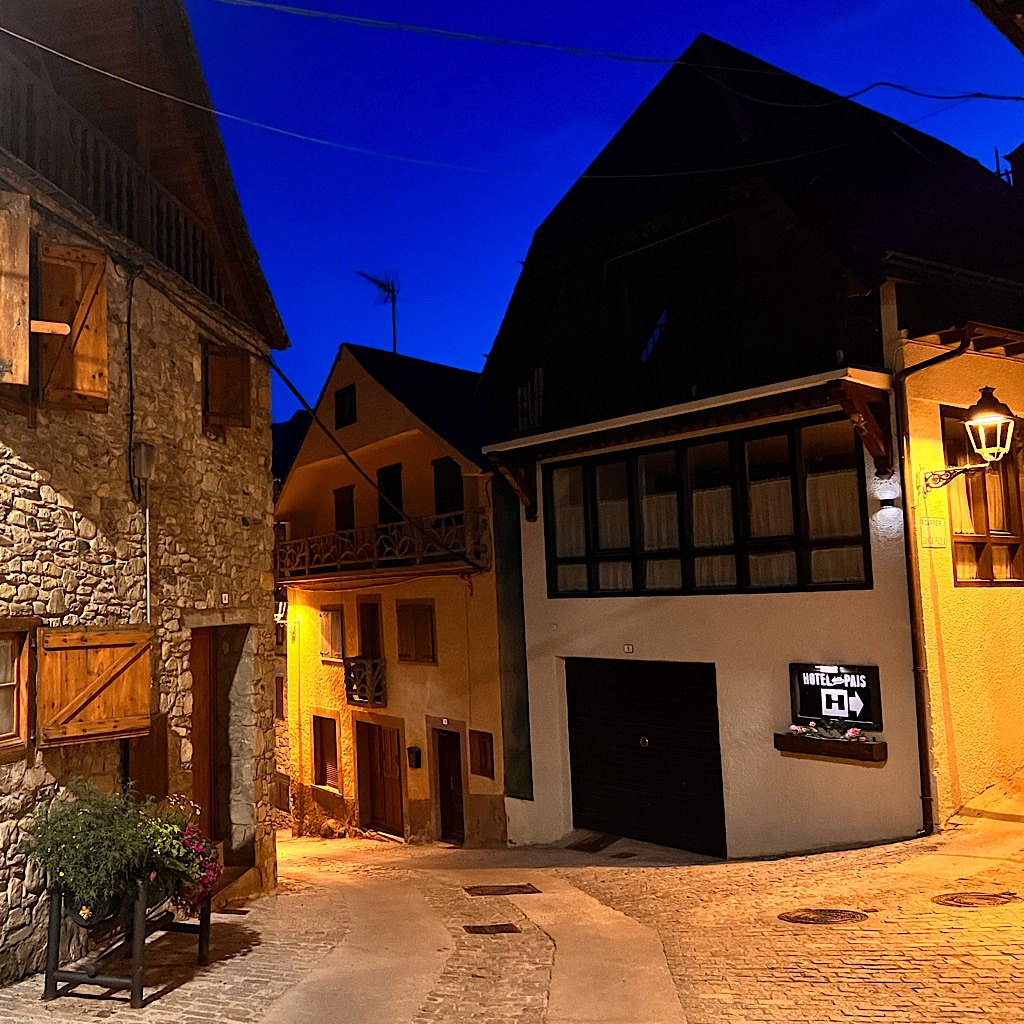
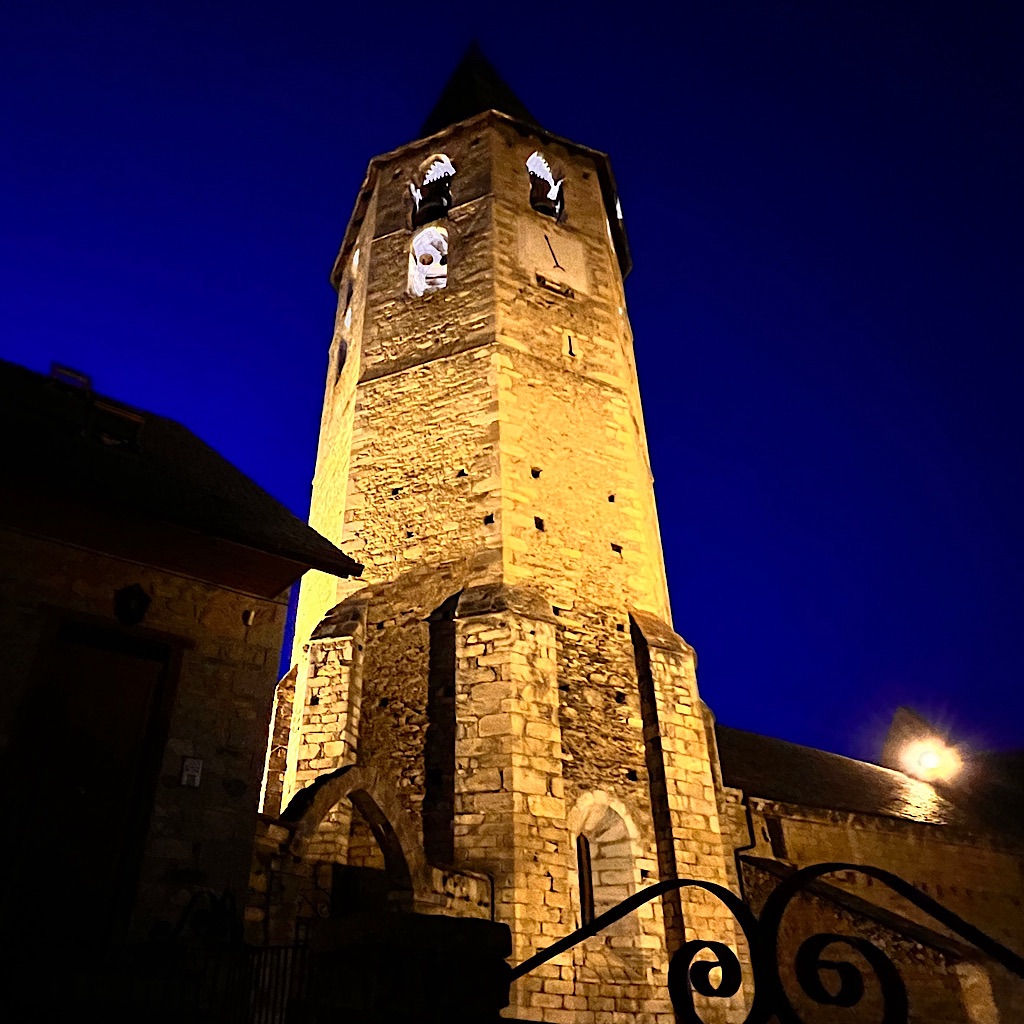
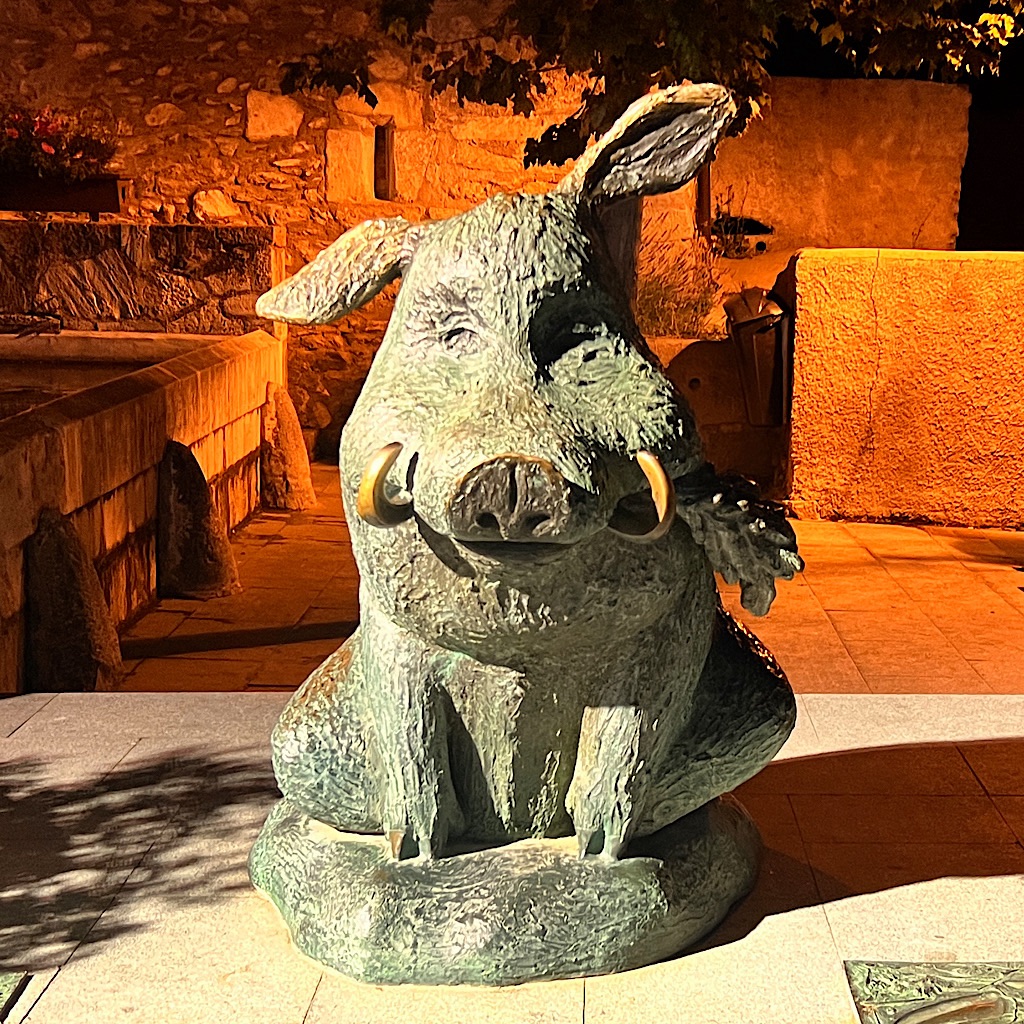
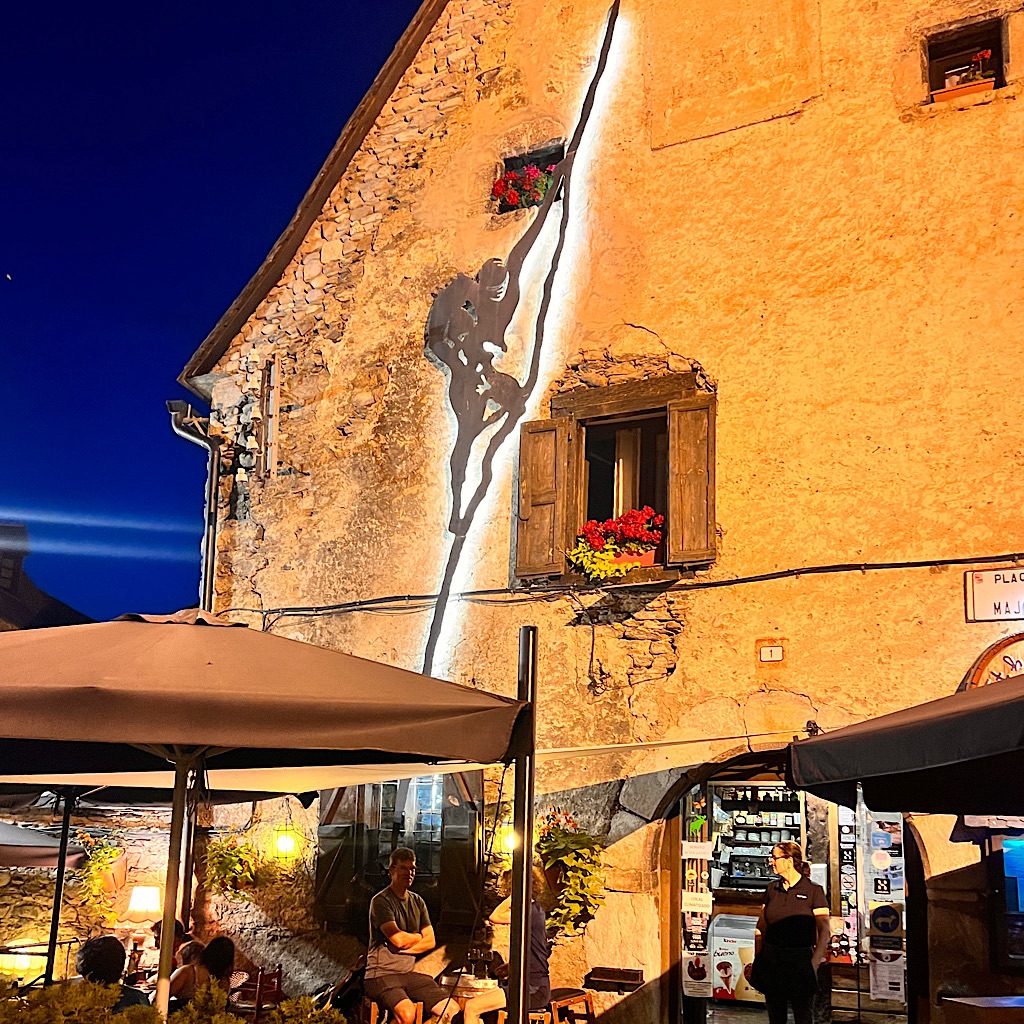
I have little to say on the day except it required a couple of short, rocky climbs, then all day descending deep into Valle d’Aran and the skiing communities.
Notably, the land begins to remind me of the Sierra full of lakes and pines and green meadows.
Dozens of day hikers pass us escaping the intense heatwave hitting Spain just now. Tamir and I put our feet in cold water, then stop at a restaurant and drink two (overpriced) cokes a piece before hitching the last kilometers into Salardú.
We all meet for lunch and have the last of our “strategy sessions.” I do meet the Dutch again while shopping on my day off, but this togetherness was a singular event – one of the happiest of my life.
Tamir only has a week left, so foes not take a day off, but we have dinner together – along with beautiful Helen!
Seeing her again is such a treat. She had a rough patch and recovered here. We have a long talk about life and plans and health and goals. I likely won’t see her again, here anyway, maybe if I visit the Peak District someday.
Salardú is a tight little (medieval?) community of stone buildings, an octagonal church on steep and narrow cobblestone streets. Lovely at night especially and I walk around a bit, before digging into the numerous chores that need doing before I jump back on trail for the Andorra section…
Stay tuned!
